|
|
Post by codystarbuck on May 19, 2021 16:13:51 GMT -5
Shazam! #2 Nice infinity cover; I never have heard who the kids are. The boy with the yellow shirt and girl in the pink sweater definitely look like siblings. I would assume they were the kids of someone at DC, though they could have been hired models. I do have to say the scale of the comic the kid is holding is closer to a Treasury Edition than the standard Bronze Age size. Maybe Golden Age size. I have a suspicion he was holding a standard magazine, rather than a comic, in the photo shoot. GCD says DC production manager Jack Adler assembled the cover, combining the photo with CC beck's illustration; but, has no info on the photo shoot. Creative Team: Main story-Denny O'Neil-writer, CC Beck-art & letters, Julie schwartz-editor. No color credit. 2nd story-Elliot S! Maggin-writer, CC Beck-everything else; 3rd story (reprint of Captain Marvel Adventures #139)-Otto Binder-writer, CC Beck-art Synopsis: "The Astonishing Arch Enemy" We are re-introduced to The World's Evilest Worm, Mr Mind, and reminded of the whole Shazam magilla.... 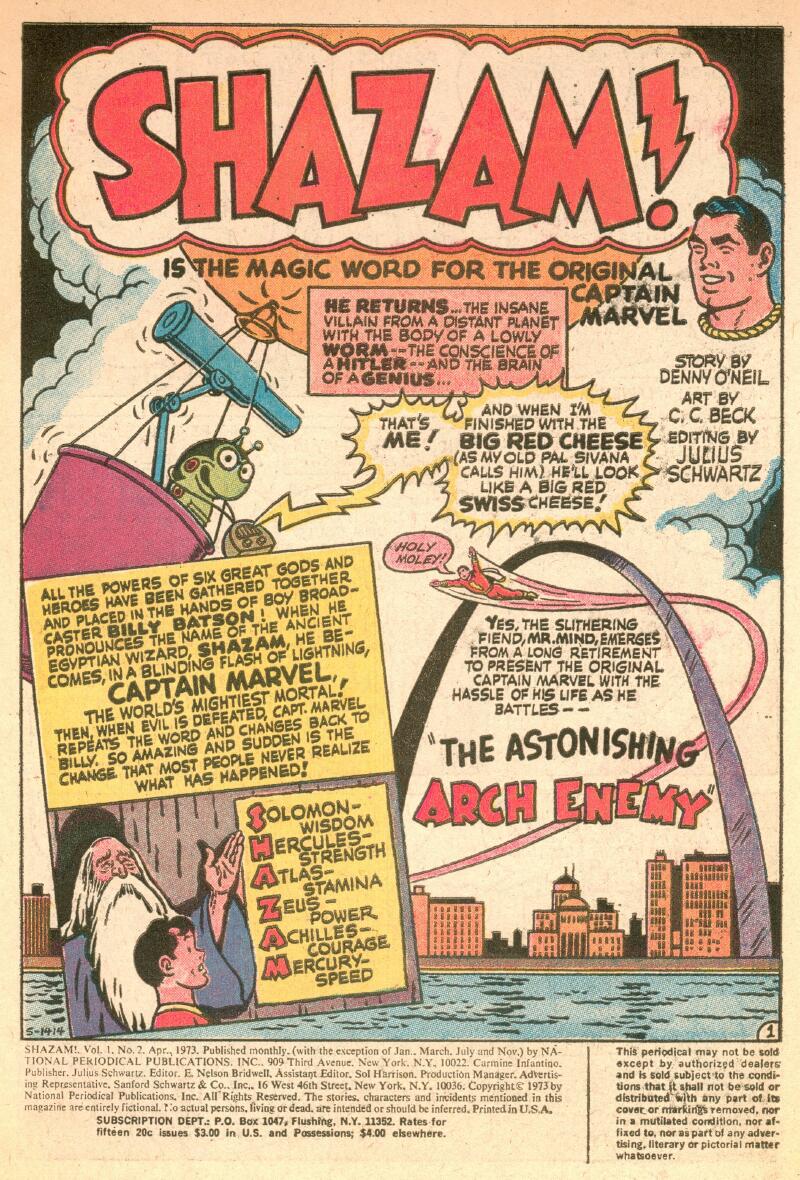 Hey, St Louis, and CC appears to be familiar with the skyline, around the Arch! Billy is hanging out in the park, adjusting to modern times and slang, including bell bottoms, righteous afros, hippies and polyester. He goes off to the museum to visit old time displaced friedn Mr Tawky Tawny, the talking tiger, who got his old job back, as a tour guide. Tawny is showing the patrons the Mr Mind exhibit, which includes displays of the activities of the Monster Society of Evil and the stuffed body of the late, demented worm.... 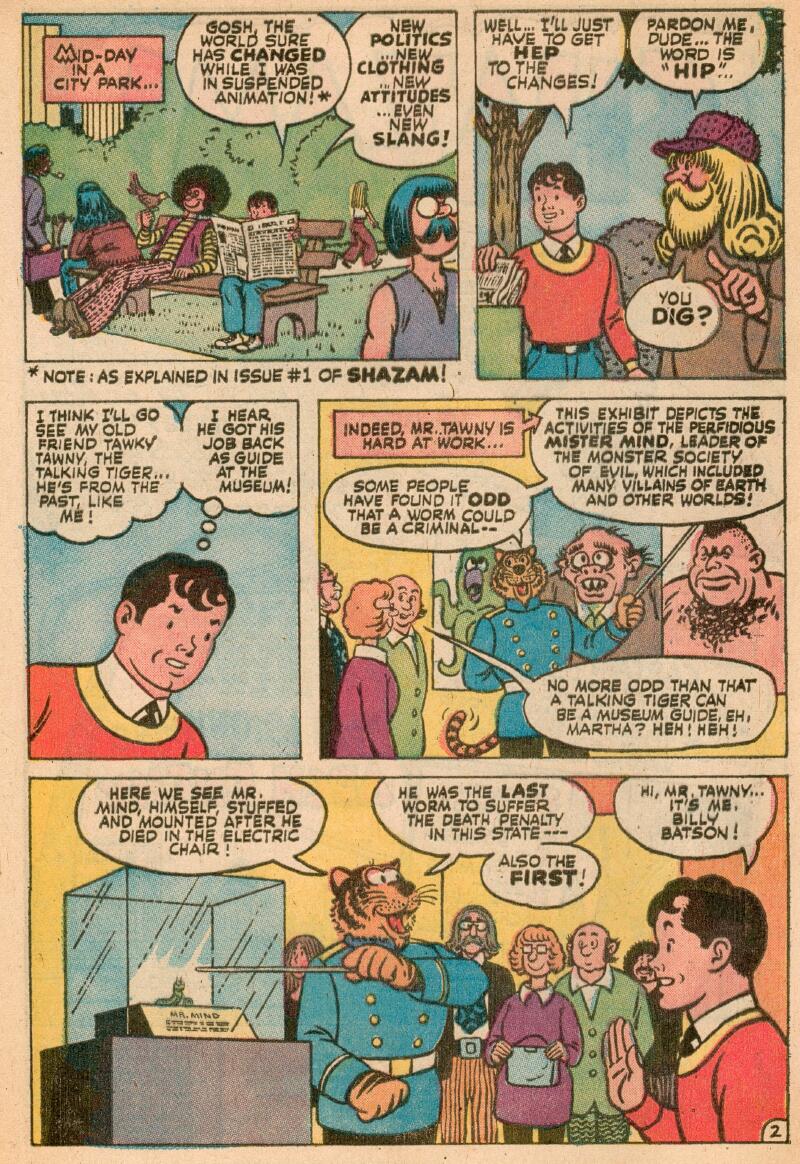 They didn't play around in the 40; executing a worm, via electrocution! Take that, Texas! Billy says hi and then there is a rumbling, as the ceiling starts to collapse. A quick magic word and captain marvel swoops in to protect the patrons from the debris and minimize the damage. Afterward, Tawny remarks that the building was just recently inspected and certified just fine and suspects foul play. The Wisdom of Solomon points Captain Marvel to a specific display and he examines the case with the stuffed body of Mr Mind. It turns out to be a fake! 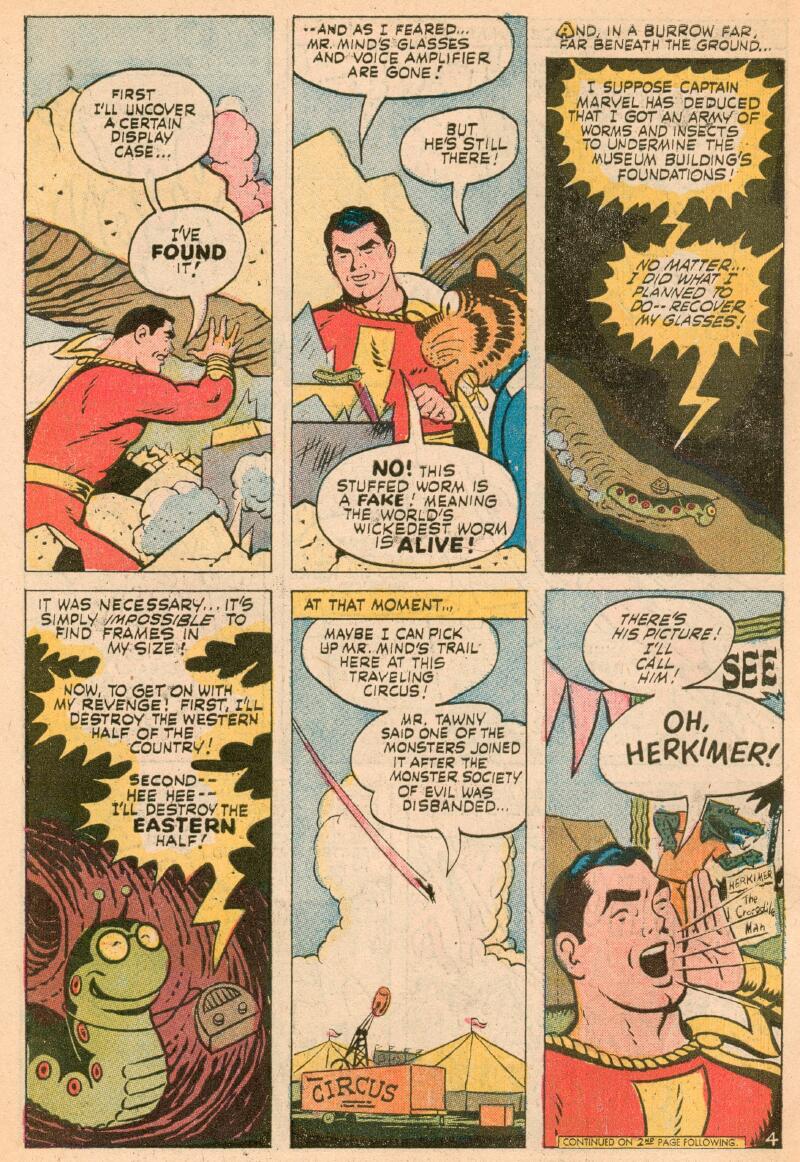 Sure enough, the glasses and vociebox are missing from the figure and Captain Marvel says it is a fake. we cut to Mr Mind, with glasses and voicebox, revealing he had worms and ants undermine the foundations, just so he could get his glasses and voicebox back! That's evil! Well, he does point out it's hard to get frames at worm size. Having worn glasses for years, I can sympathize with that. Lens Crafters isn't that wide ranged. Captain Marvel hunts down former members of the Monster Society to try to get a handle on Mr Mind's location. He goes to a circus and calls out Herkimer, one of the Crocodile Men (Herkimer, Jorrk and Sylvester), who served Mr Mind). Herkimer attacks TBRC, smashing a mallet over his head (it breaks) and biting his arm (breaking his teeth), then cooperates with TBRC's questioning. he says he was contacted by Mr Mind, to Meet Him in St Louis; but he declined, because he prefers the life of showbiz, in the circus. Captain Marvel flies to St Louis (again, captured accurately, apart from the balloon with the evil worm floating around).... 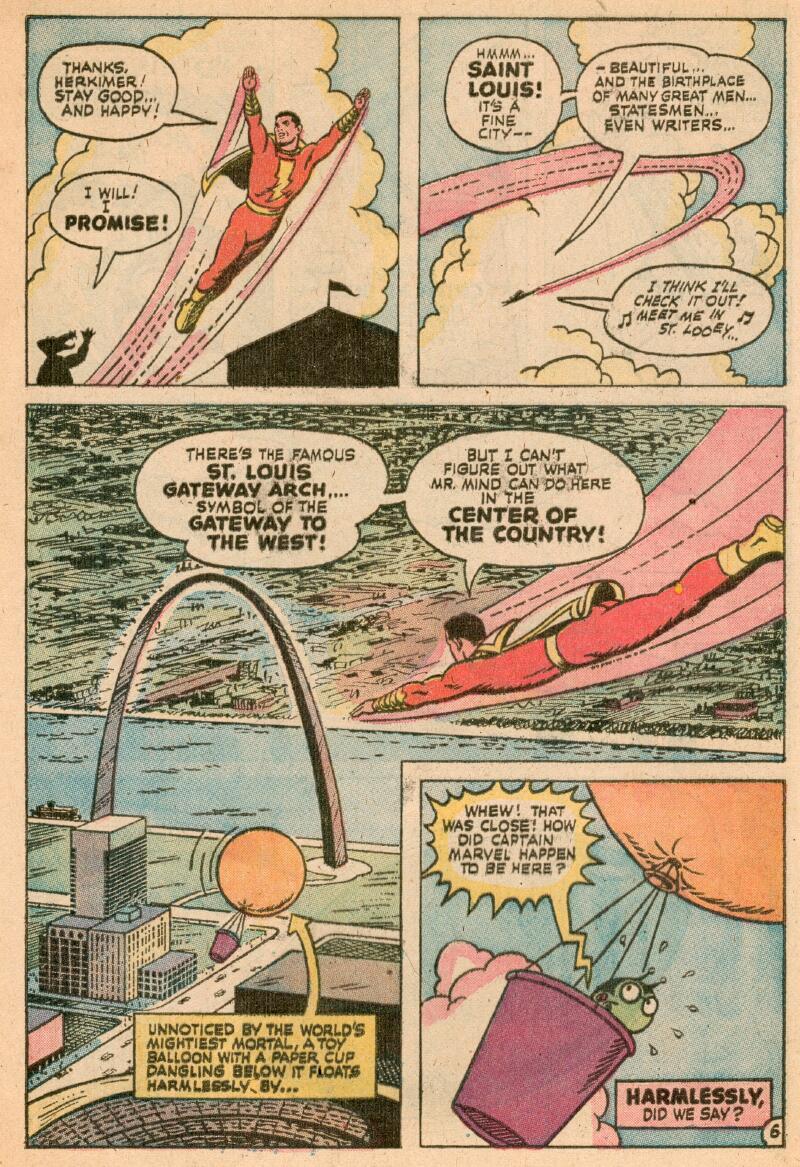 ...He wonders what Mr Mind is planning, in the center of the country (well, not the geographical center). Probably wanted to see Lou Brock steal some bases, as Busch Stadium! Or check out Six Flags. Or visit Marlin Perkins, at the Zoo. Perhaps he was going to the Chase Hotel Ballroom, to catch some professional wrestling! No, in fact, he is launching an Atomic Expanding Missile, which will destroy everything between Los Angeles and St Louis, when it reaches critical size! 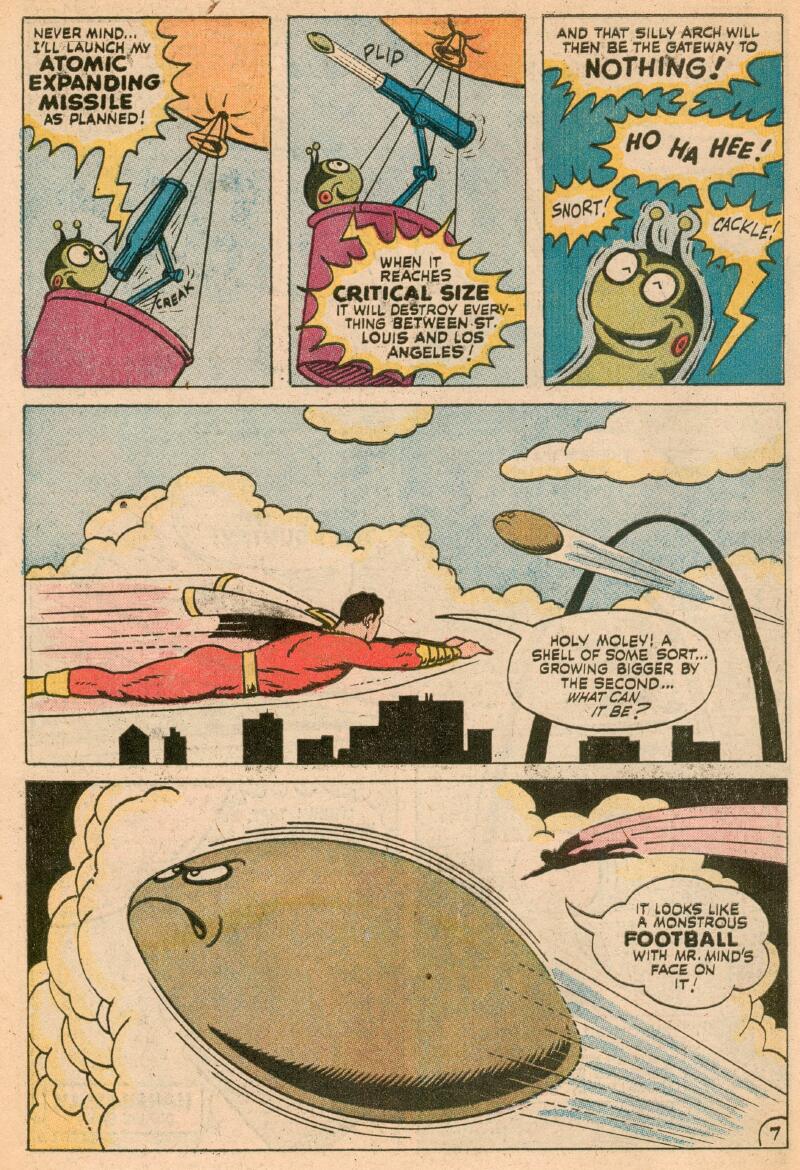 Captain Marvel gives it a kick into the stratosphere and it explodes, harmlessly, in space. Mr Mind bails out of his balloon (in a tiny parachute) and slips out of the parachute, when Le Gran Fromage Rouge nabs it. The evil worm giggles, as he gets away underground. Herr Grosser Rotter Kase isn't done yet and he bends back the Gateway Arch and lets it snap back into place, sending vibrations down into the ground, like a giant tuning fork. I'd hate to have been one of the tourists, inside, on the observation deck; or worse, in the tram car up to the deck! 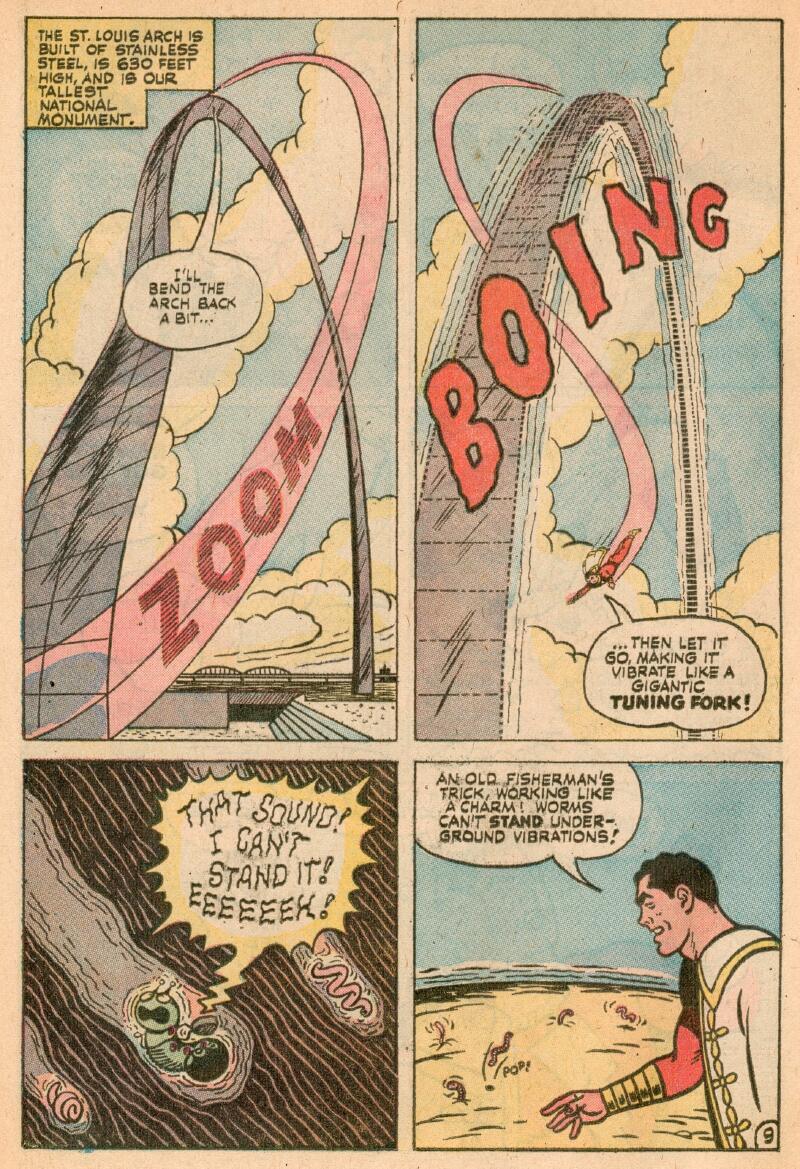 The vibrations shake Mr Mind up out of the ground, along with a gazillion other worms, but only one is wearing glasses! Captain Marvel picks him up and takes him off to jail, since the death penalty had been rescinded, in the sissy, criminal-coddling decade of the 1970s (just ask every writer of men's adventure pulps and vigilante movies). Billy Batson then catches up Mr Tawky Tawny on what happened, then goes off wondering if he can get his old job back, though we still don't know how Mr Mind escaped the electric chair (probably slimed his way out); but, we are teased that it will be told down the road. "The Nicest Guy in the World" Young Sunny Sparkle sneaks past a crowd at a book signing, one day, but is spotted and the gathered crowd is overwhelmed at what a good boy he is that they lavish him with gifts and affections... 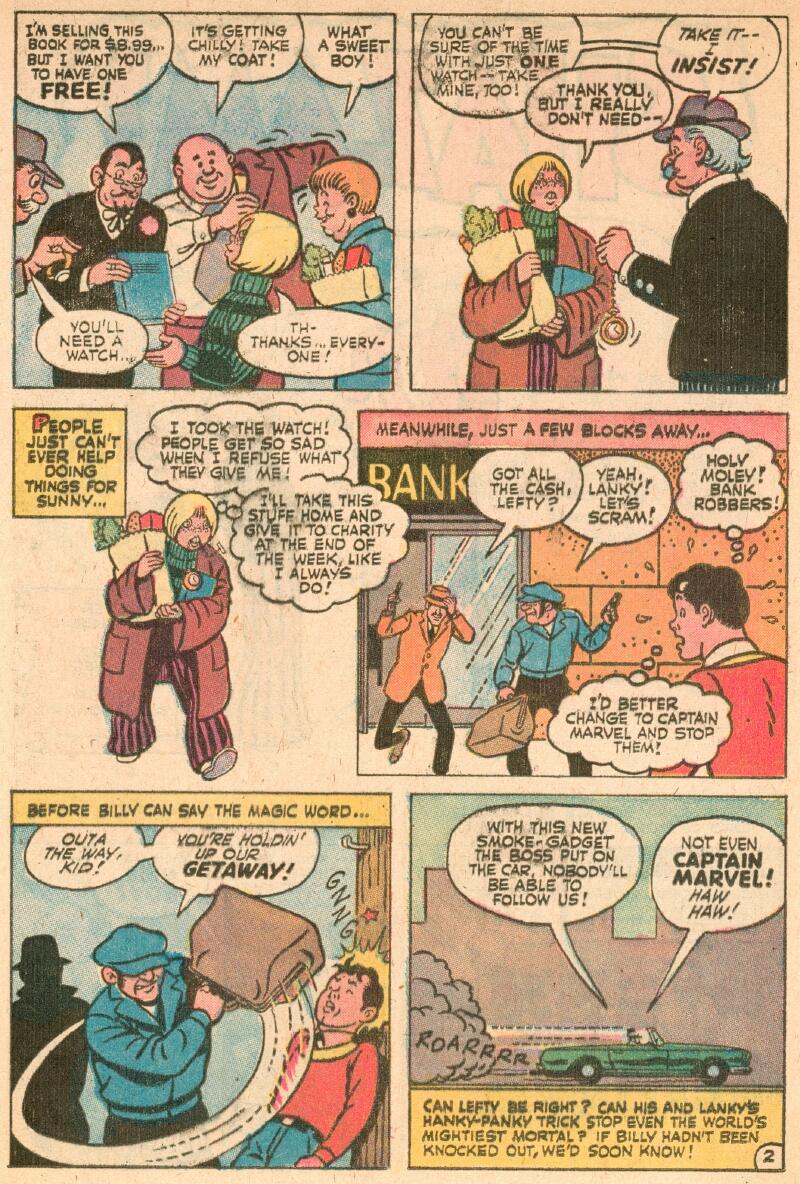 Sunny is overwhelmed and worn out as he is burdened by all of these things. Aw, poor baby; sucks to be you! Meanwhile, some bank robbers flee the scene of the crime and literally run into Billy Batson, as one of them bashes him in the head with the satchel full of loot and knocks him cold, so Captain Marvel cannot save the day. They escape in a car without a catalytic converter and an oil leak and fill the air with thick, black smoke (and toxic lead particles). Billy recovers, says the magic word, but can't see a thing. The robbers are down the street a bit and they stop when they meet up with Sunny Sparkle. They help him with his stuff and hand him the loot. Captain Marvel turns up later and helps Sunny home with his stuff and asks f he saw any crooks. he replies, only nice people. The crooks show up to their boss, who can't fathom why they handed the loot over to some kid (He was such a nice kid!). The boss goes to find him, to get the loot back. He finds Sunny, reaches into his jacket and presents him with a wad of cash, instead of a roscoe and leaves! 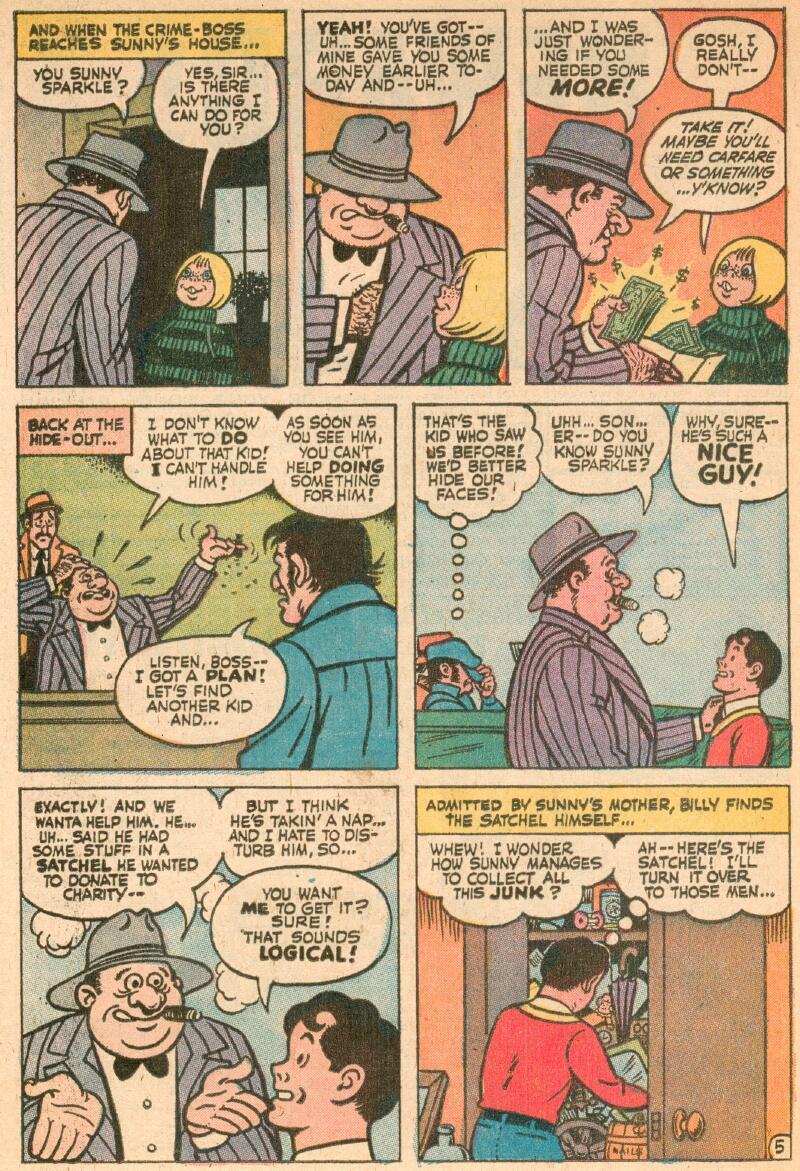 He tells the boys he couldn't do it. They need a kid! They find Billy, sucker him into believing that Sunny wants to donate a satchel to charity, but they can't find him. Billy, lacking the Wisdom of Solomon, finds that reasonable and goes off to find Sunny. He gets the satchel and hands it over to the crooks, who take off in the same polluting car and Billy realizes that they were crooks, says the word and TBRC nabs them. Sunny gets a medal for aiding Captain Marvel and is happy, because he earned it. Then, the mayor and others start handing him more gifts and he decides to become a hermit. TBRC explains he followed the crooks, through the smoke, by the sound of the car, as it also has a bad muffler. Time to Midasize! There follows a text piece about the Marvel Family, from E Nelson Bridwell (no credit; but, I am betting that it is a safe assumption)... 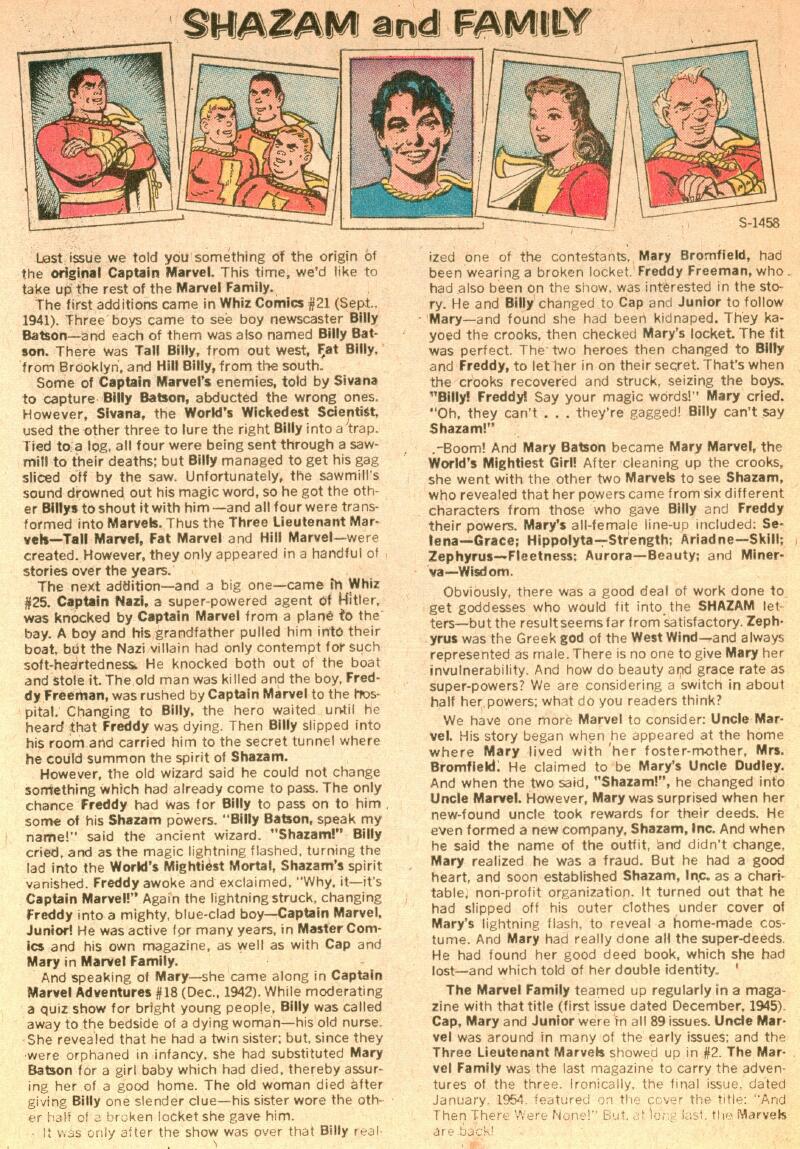 "Captain Marvel Fights Niatpac Levram!" Wizzo the Wizard is giving a street performance and unleashes a horde of rabbits upon the city... 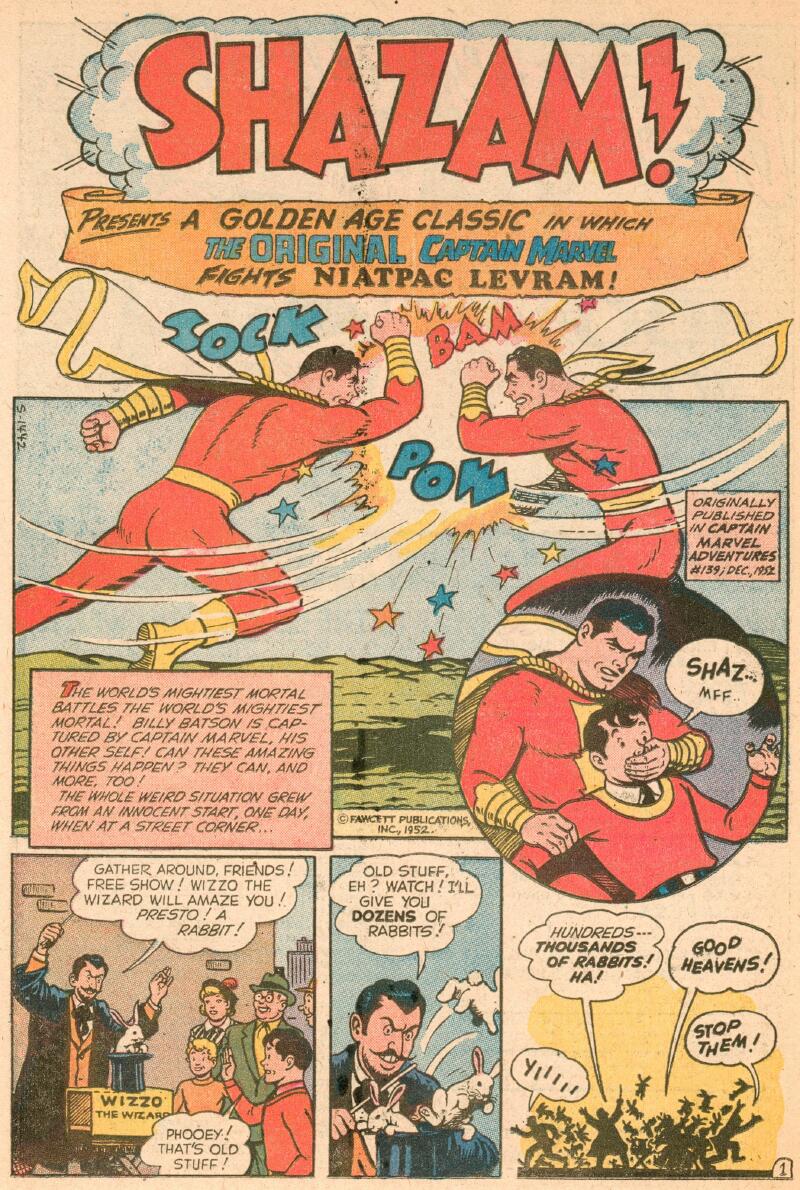 Said bunnies jump on Billy Batson, who says the magic word and Captain Marvel is left to wrangle the onery fur-bearin' critters. He finds Wizzo, who says he unleashed the rabbits to draw TBRC and said Cheese tries to stop more coming out and finally slaps the top hat onto his head. He tries to wrangle the rest and Wizzo turns his magic onto the reflection of Captain marvel, in a window, bringing it to life. It speaks backwards and says it is Niatpac Levram. He must obey Wizzo, who commands him to destroy things. Billy gets a news report, at the radio station and transforms, discovering thet Captain Marvel is still wearing the top hat. He also discovers he has no reflection in the mirror (he's a vampire!) and goes to investigate. he finds Wizzo and his reflection and gets his block knocked off...or at least the hat... 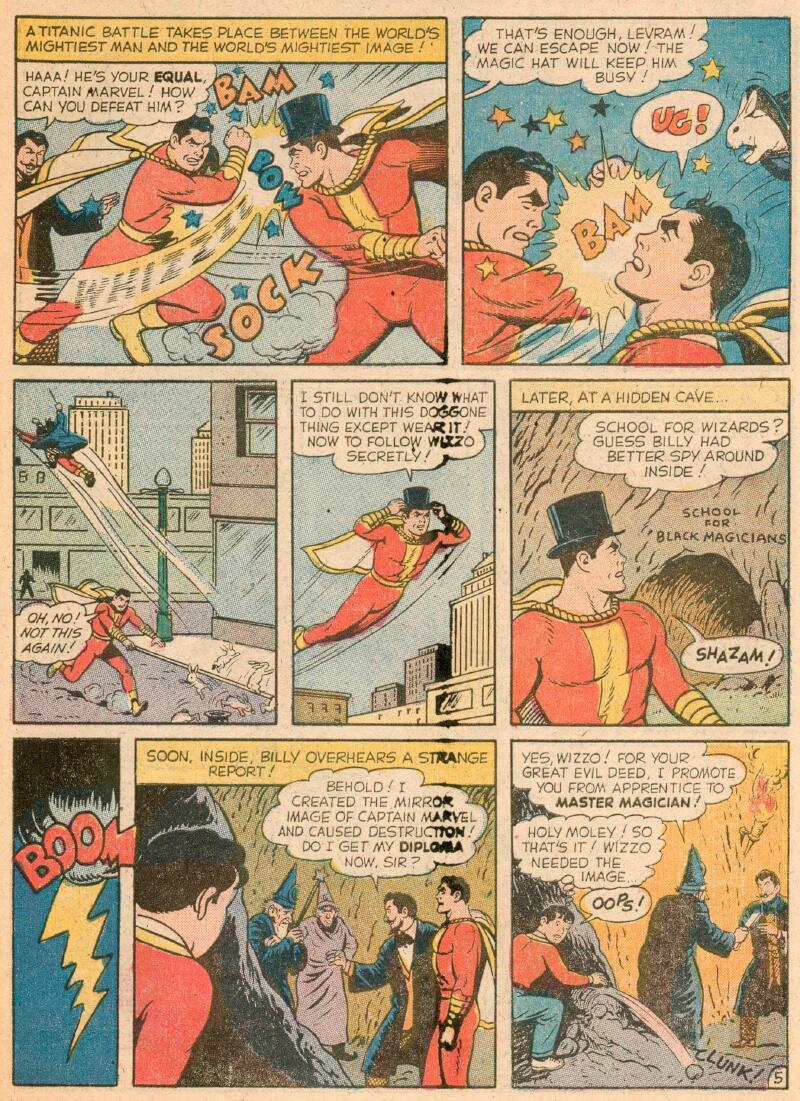 He gets it back and follows the trail of Wizzo, eventually finding a hidden cave, housing a school for black magic. Wizzo is getting his diploma, when Billy (TBRC transformed, so Billy could spy more easily) makes a noise and is attacked by ehT giB deR eseehC and gets tied up and gagged (of course). Wizzo turns him into a monster, to rub it in, but Monster Billy uses the big teeth to chew through the gag and utter the magic word (Abra-Capocus! Hocus-Cadabra! Wallawalla, Washington! Anaheim, Azusa and Cucamonga!) and changes. Captain Marvel takes off the hat, letting out the rabbits, who knock the wand from Wizzo's hand. Forward Cap grabs it and casts a spell on Backwards Cap, sending him back into the mirror and Wizzo is punched out and arrested. The back cover says you can earn fabulous prizes by selling seeds, for the American Seed Company. I suspect most kids ended up with a prize of a prize book and 50 seed packets. Thoughts: The lead story is a decent reintroduction to Mr Mind, who made only one appearance at Fawcett, though it was in a long serial, which ran from Captain Marvel Adventures #22-46, with Mr Mind first appearing at the end of the adventure in issue #26, and his first full story, in full form, in #27. The huge success of the Republic serial, The Adventures of Captain Marvel, led to the idea to run an epic across successive issues of the comic, which was unheard of, in those days. A few stories had crossed over two issues (such as Captain Marvel's battle with a brainwashed Spy Smasher); but, it was extremely rare, in those days of 48 page comics. Captain Marvel fought a succession of Mr Mind's henchmen and allies, before finally capturing the worm and putting him on trial, where he got the Death Sentence. Now there's an ending! Here, we learn that he wasn't fried after all, though we aren't show how (to get us to read a return adventure, which would explain it, or they just hadn't thought that part up). On top of it, we get an adventure in St Louis, which didn't see a ton of superhero action, until Son of Satan debuted. CC Beck obviously knew what the city looked like, in 1973, as he has the skyline, from The Mississippi River, correct. He also has the proximity to Busch Stadium relatively correct. The only thing missing was the paddle boats giving tours up and down the river, and the barge traffic going past. Can't have everything, I suppose. Denny O'Neil was from St Louis, so he may have helped beck with the layout of the city, though beck was originally from Minnesota and probably had some familiarity with the city (he also studied at the Chicago Academy of Fine Arts, which would have been even closer proximity, than Minnesota). Once again, the story is simple and direct, but it works pretty well. I have a sneaking suspicion that the expanding bomb, shaped like a football, was so that it could be seen flying through the Arch, like a goalpost, which is an old joke, in this part of the world (we used to drive down to St Louis, on a few occasions, to go to Six Flags and to see a Cardinals game). It is designed for young readers, hence the simplicity, but the storytelling is clear and the adventure light-hearted fun. The bit with Herkimer is actually a bit amusing, with the timing of the joke, across panels. The second story, from Elliot S! Maggin is not quite as good, though it isn't bad. It has the flavor of some of the Fawcett tales (the shorter ones); but, Sunny Sparkle is a bit underdeveloped, even for kids. It kind of has the feel of a Super Friends adventure, as you could easily turn the smoke and noisy muffler into an ecological PSA. Maggin was writing Superman, though his stories were a bit more sophisticated than this (Maggin is still one of the best superman writers, ever, in my book); but he adapts well enough to this style of things. The story is paced well and the crooks continually handing money over to Sunny is kind of funny. The ending needed a better punchline, but it is fine. Any kid who was in the Richie Rich or Casper stage would have enjoyed this, for what it is. The reprint story is a typical Fawcett tale, as Billy encounters a strange event, gets Captain Marvel involved, then it goes haywire, as the villain perpetrates some kind of magic (or gadgetry) to confound Captain Marvel. here, it is his own reflection, which is equal in strength and power. Only real issue is that they didn't letter entire sentences backward, gust reversed the letter ordering of each word. The mirror image of Captain Marvel should be Levram Naitpac and he would be "!eseehC deR giB ehT." I should know, I used to sit there and reverse lettering of signs and things when is was stuck somewhere and bored, like during the church sermon (Bible stories were cool; but the sermons bored me to tears) or at the doctor's office. We also see that the transformation from Billy to Captain marvel could have special circumstances, as Captain marvel is still wearing the top hat, but Billy is never seen wearing it, when they switch. Obviously, Billy doesn't gust age into Captain Marvel, he actually switches places, physically. This informs every pastiche of him, from Mar-Vell (when Roy Thomas wrote him and added Rick Jones, as an ersatz Billy Batson) to Marvelman/Miracleman (both the original Marvelman stories of Mick Anglo and his studio and the Alan Moore revamp, in Warrior). That is part of why I always had a problem with the later concept that Captain marvel retains Billy's mind, in the adult body. It flies against what we had seen, even though Roy was starting things from scratch. Jerry Ordway gave things a better rationale with the retcon origin, in Power of Shazam (graphic novel). So, one good and one "meh" modern story and a reprint of an average, though not classic Fawcett tale. Here we see why the return of Captain Marvel was a mixed bag, for 1970s fans. The hero is back and there are nods to the past, as well as reprints of Fawcett material, for a new generation. however, we also see that the quality of the modern stuff doesn't quite match the old and doesn't always work, even for young kids. in this issue, the story continuing Billy reacclimating to the world, after 20 years frozen, still has some depth to it, relatively speaking. The Maggin story lacks that hook and is more of a pastiche of old styles, which makes it seem less. It still has some imagination, but there is a certain quality that does seem lacking. With a longer story, I think Maggin could have developed it more, especially Sunny Sparkle and come up with something better.
|
|
|
|
Post by majestic on May 19, 2021 20:12:55 GMT -5
I remember buying these off the stands. I have fond memories of them. I still like them today as an adult. Granted they are simplistic but they are a refreshing "palate cleanser" when reading some other grittier stories.
|
|
|
|
Post by String on May 20, 2021 13:28:37 GMT -5
DC just released Shazam The World's Mightiest Mortal Vol 3 which reprints the Bridwell/Newton run from World's Finest and Adventure Comics #491-492. To my knowledge, this is the first time this run has ever been collected/reprinted and it's been long overdue.
I think it was mentioned earlier in the thread but yes, Bridwell did help compile the stories featured in Shazam From the 40s to the 70s. In fact, O'Neil's re-intro origin story of Cap from #1 is reprinted here. In his intro, Bridwell delivers a great overview of the character's history, Fawcett, and DC's efforts (stalled and otherwise) in bringing him back.
I've been a fan of Captain Marvel since his live-action TV show and the Saturday morning cartoon. However, I never saw any issues of this initial Shazam comic on any spinner racks in my neck of the woods. My first comic exposure to Cap was in World's Finest (which is why Newton's rendition of the characters remains one of my top favorites ever). The first issue of this run that I ever saw was #5 and found that for pennies in a back-issue bin. DC first reprinted this entire run (#1-35) in a single volume of Showcase Presents and more recently, collected them (in color) in the first two volumes of Shazam The World's Mightiest Mortal.
I've since acquired the majority of this first run and I would agree, the stories are simple as is the art but overall, I still enjoyed them. Reading them brings a smile to my face and joy which is always a plus. Bridwell/Newton is a definite highlight and Ordway's POZ series is a classic to me. I remember reading Thomas' mini-series when it was first released but don't recall any hatred for it at the time but I was younger and haven't re-read it in quite some time. Billy Batson and the Power of Shazam was far better than I first thought it would be. Jeff Smith's mini was interesting. As for Geoff Johns, he deserves some criticism for his handling of the characters later on (especially Mary) but I will say, his overall redemption arc with Black Adam (which began in JSA) is one of the best character stories I've ever read. He made Teth-Adam into so much more than a basic evil version of Shazam.
Your comments on #2 raise an interesting point for me, this ambiguity over Billy and Cap. Are they the same? Are they two separate persons? I can see either view but for me, I've always thought Cap was Billy changed into an adult. It makes more sense to me seeing as how one of the underlying appeals of the character is the ultimate in boy childhood wish fulfillment: say a magic word and turn into a superhero! I liked the later appendage that Billy turns into a idolized image version of his father which speaks to the tragedy of his parents' death (or murder depending on your origin). I also like the idea that the Wisdom of Solomon also serves to guide a young Billy whilst transformed.
If they are two separate people instead, then I have to ask where is Cap when he's not around? Or Billy when he's not? Are they at the Rock of Eternity? At least Rick Jones and Mar-Vell had the Negative Zone. Also, this would seem to undermine the Wizard's actions. He gave unto Billy the power of these gods. If Cap was a separate entity, then wouldn't the Wizard had said, I give unto you access to this champion?
Plus, was there any such ambiguity surrounding Mary and Freddy? It seems to me that Mary Marvel IS Mary and Junior IS Freddy. So why would Billy be different? (Other than being the first to have the power).
|
|
|
|
Post by codystarbuck on May 20, 2021 21:26:55 GMT -5
DC just released Shazam The World's Mightiest Mortal Vol 3 which reprints the Bridwell/Newton run from World's Finest and Adventure Comics #491-492. To my knowledge, this is the first time this run has ever been collected/reprinted and it's been long overdue. I think it was mentioned earlier in the thread but yes, Bridwell did help compile the stories featured in Shazam From the 40s to the 70s. In fact, O'Neil's re-intro origin story of Cap from #1 is reprinted here. In his intro, Bridwell delivers a great overview of the character's history, Fawcett, and DC's efforts (stalled and otherwise) in bringing him back. I've been a fan of Captain Marvel since his live-action TV show and the Saturday morning cartoon. However, I never saw any issues of this initial Shazam comic on any spinner racks in my neck of the woods. My first comic exposure to Cap was in World's Finest (which is why Newton's rendition of the characters remains one of my top favorites ever). The first issue of this run that I ever saw was #5 and found that for pennies in a back-issue bin. DC first reprinted this entire run (#1-35) in a single volume of Showcase Presents and more recently, collected them (in color) in the first two volumes of Shazam The World's Mightiest Mortal.
I've since acquired the majority of this first run and I would agree, the stories are simple as is the art but overall, I still enjoyed them. Reading them brings a smile to my face and joy which is always a plus. Bridwell/Newton is a definite highlight and Ordway's POZ series is a classic to me. I remember reading Thomas' mini-series when it was first released but don't recall any hatred for it at the time but I was younger and haven't re-read it in quite some time. Billy Batson and the Power of Shazam was far better than I first thought it would be. Jeff Smith's mini was interesting. As for Geoff Johns, he deserves some criticism for his handling of the characters later on (especially Mary) but I will say, his overall redemption arc with Black Adam (which began in JSA) is one of the best character stories I've ever read. He made Teth-Adam into so much more than a basic evil version of Shazam. Your comments on #2 raise an interesting point for me, this ambiguity over Billy and Cap. Are they the same? Are they two separate persons? I can see either view but for me, I've always thought Cap was Billy changed into an adult. It makes more sense to me seeing as how one of the underlying appeals of the character is the ultimate in boy childhood wish fulfillment: say a magic word and turn into a superhero! I liked the later appendage that Billy turns into a idolized image version of his father which speaks to the tragedy of his parents' death (or murder depending on your origin). I also like the idea that the Wisdom of Solomon also serves to guide a young Billy whilst transformed. If they are two separate people instead, then I have to ask where is Cap when he's not around? Or Billy when he's not? Are they at the Rock of Eternity? At least Rick Jones and Mar-Vell had the Negative Zone. Also, this would seem to undermine the Wizard's actions. He gave unto Billy the power of these gods. If Cap was a separate entity, then wouldn't the Wizard had said, I give unto you access to this champion? Plus, was there any such ambiguity surrounding Mary and Freddy? It seems to me that Mary Marvel IS Mary and Junior IS Freddy. So why would Billy be different? (Other than being the first to have the power). In the Fawcett stories, Captain Marvel always referred to Billy Batson by his name, as a separate person. Captain Marvel could be construed as an adult Billy, perhaps brought through time; or, he might be an interdimensional being that Shazam brings forth, like a genie. Fawcett left it up to the imagination. With Junior, he was granted part of the power of Captain Marvel, by saying his heroes name. The logic seemed to be because his power didn't come from Shazam, he is not turned into an adult or replaced by an adult. Mary gains her abilities from different mythical figures; so, her transformation may be rationalized as merely altering her form, as it exists. I've never come across a Fawcett story that addresses it. It just is. The reality is that Captain Marvel was made an adult, from the start, to compete with Superman and other adult heroes, with the ultimate wish fulfillment of a child saying a magic word and becoming an adult. Junior was, basically, a sidekick, who was supposed to represent the kids who read the books; and, then, Mary was there for the girls. That was the general formula of the 40s. I always liked Jerry Ordway's handling of the situation, that Captain Marvel is the image of Billy & Mary Father, CC Batson (and homage to CC Beck) and that Captain Marvel's powers all come from Shazam and the Rock of Eternity. When Junior and Mary come along, each appearance reduces Captain marvel's power, by a third. So, he is at his weakest when all 3 are around. There is an early story in Whiz comics, where they introduced 3 "Lieutenant Marvels." Billy Batson meets 3 young men, also named Billy Batson, who, during the story, say the magic word and are transformed into Marvel versions of themselves. There was "Tall," "Fat" and "Hill" (as in hillbilly), who then became Tall Marvel, Fat Marvel and Hill Marvel. It was kind of dumb; but, was a pretty good story (used to have the original comic, one of the handful of Golden Age issues I ever found). I seem to recall that they either reappear in this series or it was one of the reprint stories. The Showcase Presents does not include all of the material from this run. DC only licensed the reprint stories, originally, and does not hold the copyright on them. All of that material was skipped. Issues 21-24 were entirely Fawcett reprints, apart from some feature pages . No idea about the other reprints. I agree that Newton was the best modern artist DC put on the feature, as he was a huge fan, had a classic line, and he and Bridwell were in tune about all of the classic characters. They actually started a revamp, with the last issue of the series, with Alan Weiss on art, which DC made a big deal about in Amazing World of DC Comics and in house ads. They yanked the series after the one issue, then carried over to Worlds Finest, where Newton came on board. I can't wait to get to that material, as I haven't looked at it in a long time and just remember how gorgeous it was. I also have some images I saved from the old Art of Don Newton website, before it disappeared, with some of his fanzine art of Captain Marvel. I wish the site was still up, as it had a bunch of convention photos of him a nd some others as the entire Marvel Family and CC Beck as a special guest of the convention. Love Newton's work and have contemplated doing a review thread of his work from Charlton on, up to his untimely death of a heart attack, as he was just taking over Infinity, Inc. I covered his Return of the New Gods material, in my review thread of Kirby's 4th World. He was also one of the best Phantom artists of all time, rivalling Jim Aparo, for comics. |
|
|
|
Post by mikelmidnight on May 21, 2021 12:31:59 GMT -5
In the Fawcett stories, Captain Marvel always referred to Billy Batson by his name, as a separate person. Captain Marvel could be construed as an adult Billy, perhaps brought through time; or, he might be an interdimensional being that Shazam brings forth, like a genie. Fawcett left it up to the imagination.
The Fawcett stories typically made clear Cap was a different person:
On one occasion, Billy whispered Cap's name during a test; Cap showed up as a shadowy figure who whispered the answers to Billy.
On another occasion, Billy deflected the lightning to someone else, and they became Captain Marvel, and the pair were able to chat for the first time.
Unverified, but I read once that Shazam referred to Cap as his son.
On the other hand …
the was an episode where Billy leapt into the air and then fell to the ground … because he forgot to say his magic word! … which clearly assumes Billy's consciousness is identical with Cap's.
|
|
|
|
Post by codystarbuck on May 22, 2021 20:54:04 GMT -5
Shazam! #3 The Big red Cheese is joined by the Little Blue Cheese and his sister Cheese, on the cover. Inside, Junior and Mary turn up in the Fawcett reprint story, but not one of the new ones (well, Freddy freeman does appear, in the main story; but, Captain Marvel Junior doesn't get any action. Other than what amounted to cameos in issue #1, they haven't had any modern doings, yet. Elvis was likely disappointed, as Freddy should be TCB! 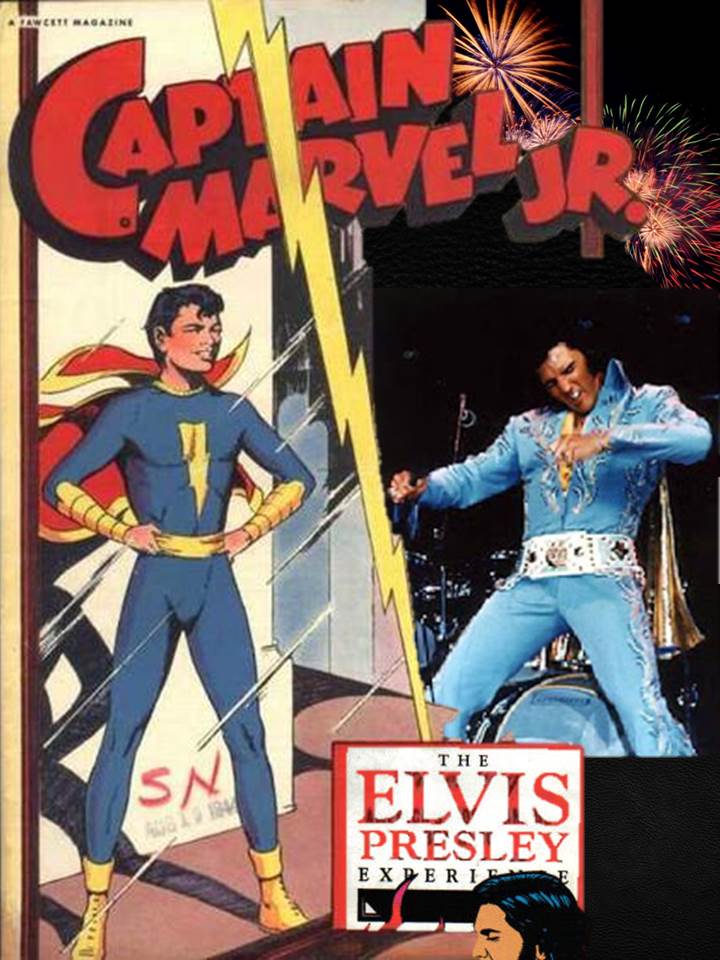 Creative Team: Creative Team: "A switch in Time"-Denny O'Neil-writer, CC Beck-art, Julie Schwartz-editor "The Wizard of Phonograph Hil"-Elliot S! Maggin-writer, CC Beck-art, Julie-editor "Witches Tale"-Otto Binder-writer, Pete Costanza-art, original story published in Marvel Family #4 (1946) Synopsis: "A Switch in Time"-Billy Batson is at a dance, but feels out of place, as the clothes, music and dance styles are all different to him, after 20 years in suspended animation. He has new (ugly) duds, but it doesn't help him adjust and he storms off and says the magic word, to go see the Wizard, for some ghostly advice. 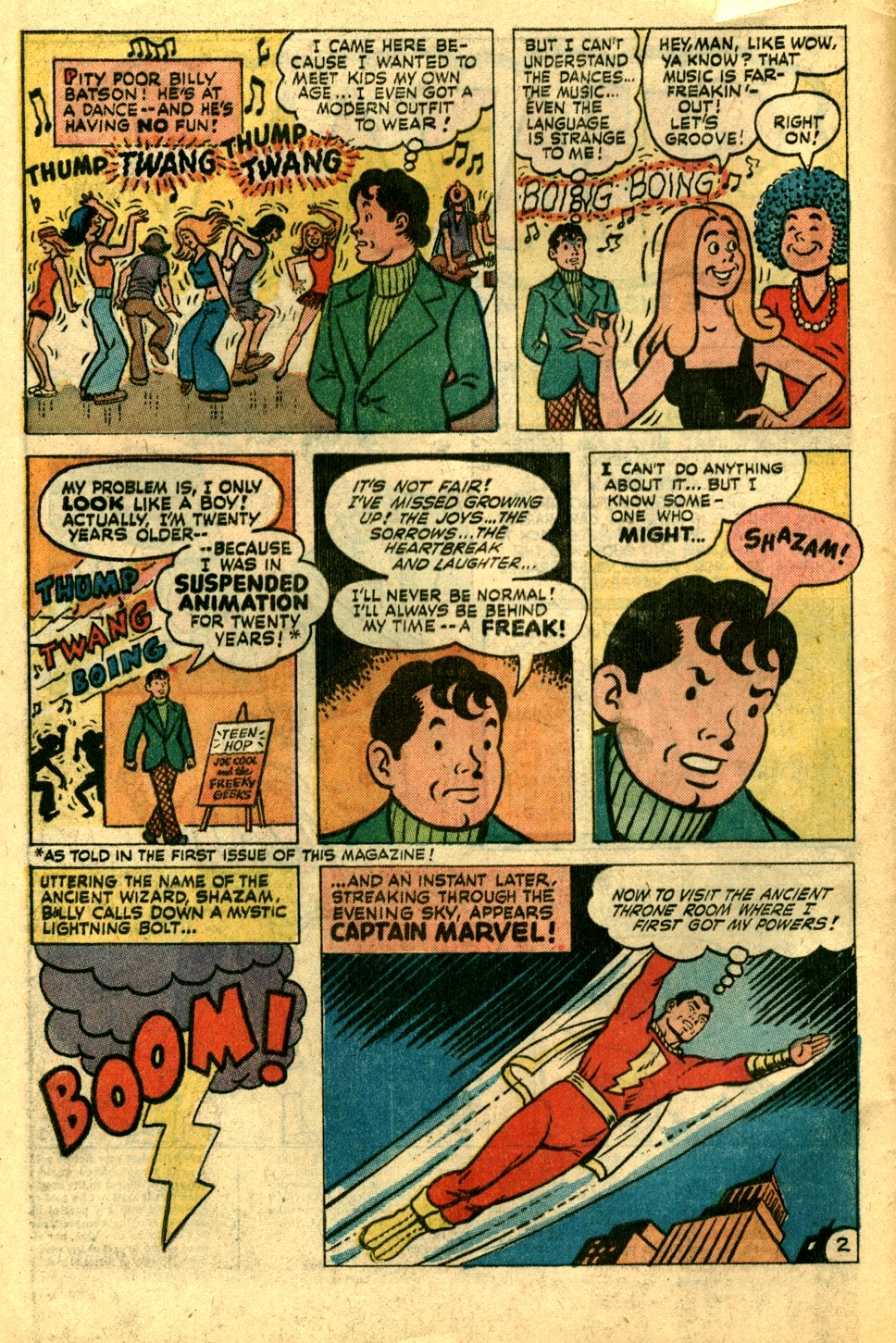 Sheesh; is Billy colorblind? Or, judging by the trousers, deaf? I think the guy with the righteous afro played Bernie, on Room 222!  (David Joliffe, the white dude, on the right) Captain Marvel lights the old brazier, grabs a Mister Mistie and raps with the bearded one, telling him about Billy's woes. Shazam says he could speed up Billy's time stream, but warns Il Gran Formaggio Rosso that meddling with time streams is dangerous. He tells Captain Marvel to do the old switcheroo and Billy appears, fully grown, though looking like an older version of himself, not Captain Marvel. Shazam splits and Billy motors off to enjoy life as an adult. Meanwhile, amateur magician Shagg Naste is kicked out of the lobby of Station WHIZ (Where the music flows!) and lets us know he flunked out of magician school, so his tricks only work on people under 16. Oooooookaaaayyy! 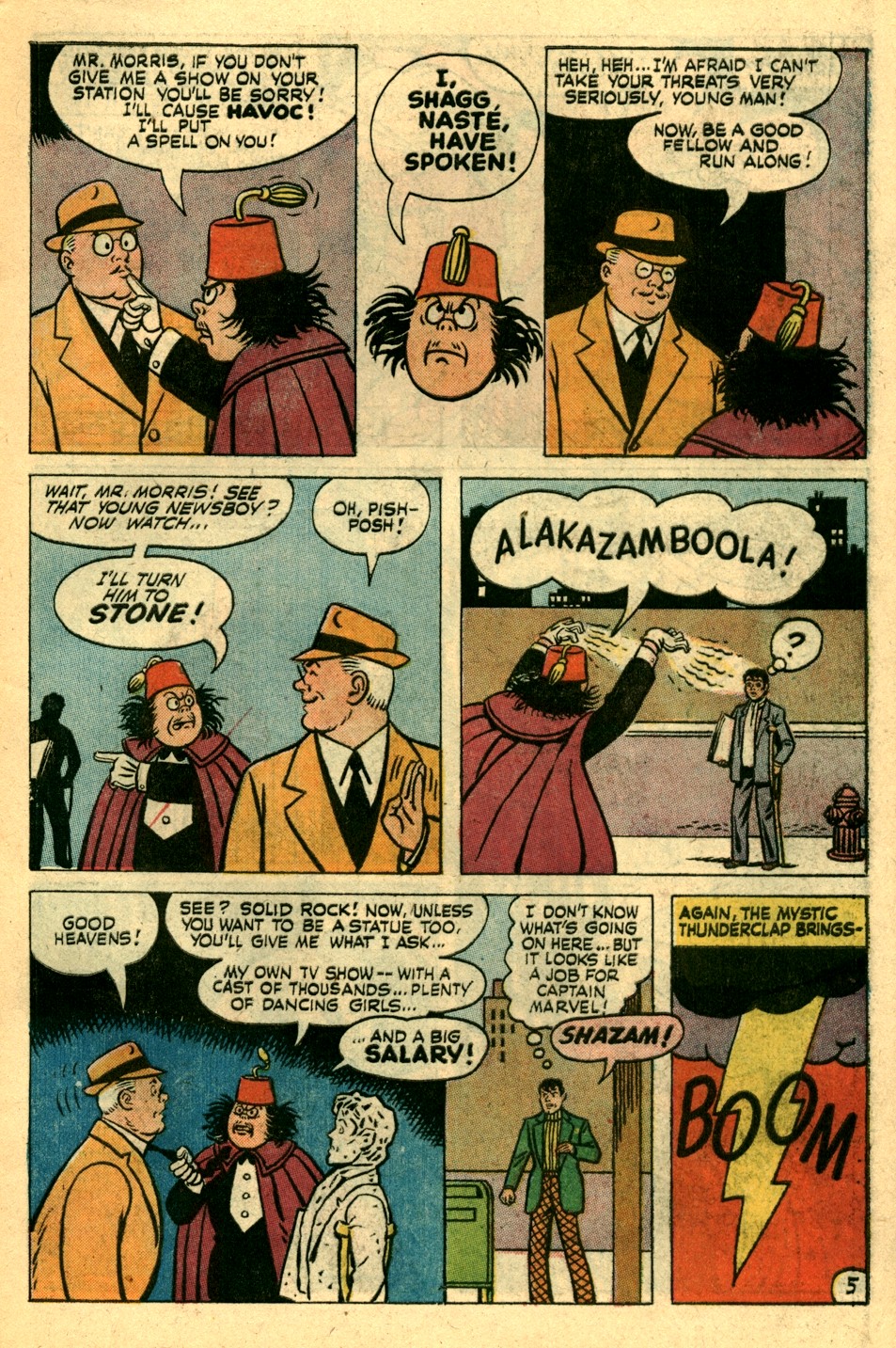 Apparently, he still got in with the Shriners! He runs into the station owner/manager, Sterling Morris and makes threats and uses the conveniently nearby Freddy freeman to try to extort his own radio show out of Morris. He turns Freddy to stone and threatens to do the same to Morris. Billy happens along, says the magic word and turns into a teen Captain Marvel (sort of, it's a bit inconclusive, the way CC draws him) and the spell can't turn him to stone, but sends him looping, out of control... 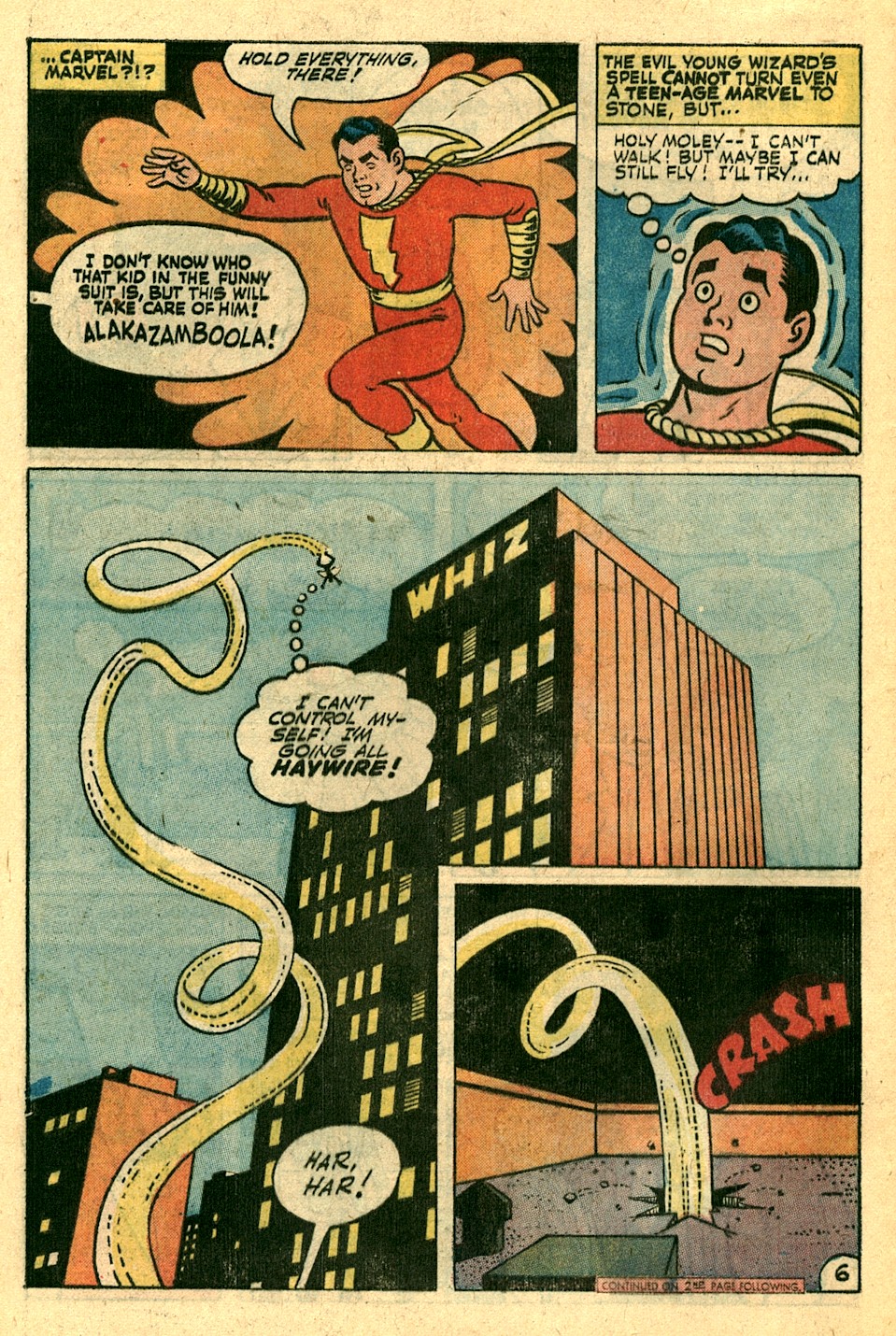 Teen Marvel switches to adult Billy (boy, this is getting confusing and it looks like CC is thrown off, too, as adult Billy is now squinting), runs down a flight of stairs, confronts Shagg and slaps him around. Shagg runs off and the spell wears off Freddy. Sterling Morris and Freddy do not recognize Billy and he is spooked into going back tot he Wizard to change things back. "The Wizard of Phonograph Hill"-Billy Batson is walking past the house of Phonograph Hill, when he runs into the owner, Thomas Kilowatt, an inventor. Billy recounts why he is still a boy and Kilowatt asks for air time to announce his new invention, Billy arranges it and he makes the World's Most Vague Announcement... 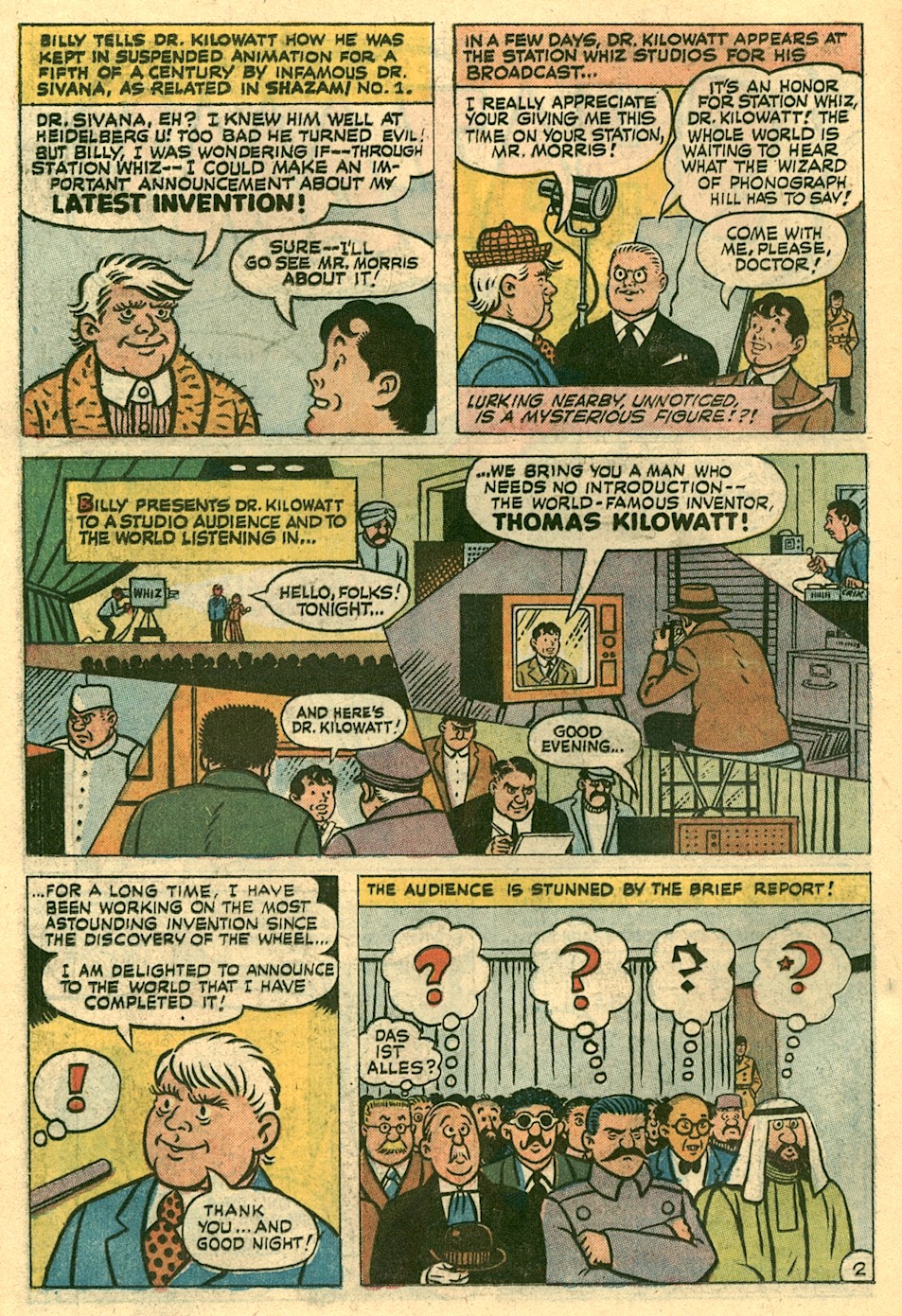 Joseph Stalin is not impressed! Kilowatt refuses to divulge what the invention is, lest it fall into evil hands and then is attacked by said evil hands (and bodies) and Billy does you know what and you know who appears and kicks you know what. Dr Kilowatt thanks TBRC and he switches back to Billy (but no one can see the transformation, even when he does it in front of you) and then Arab agents grab Billy and Kilowatt and gag them and tie them up. The Arabs are then bashed on the head by Russian Commies, who lose out to English criminals... 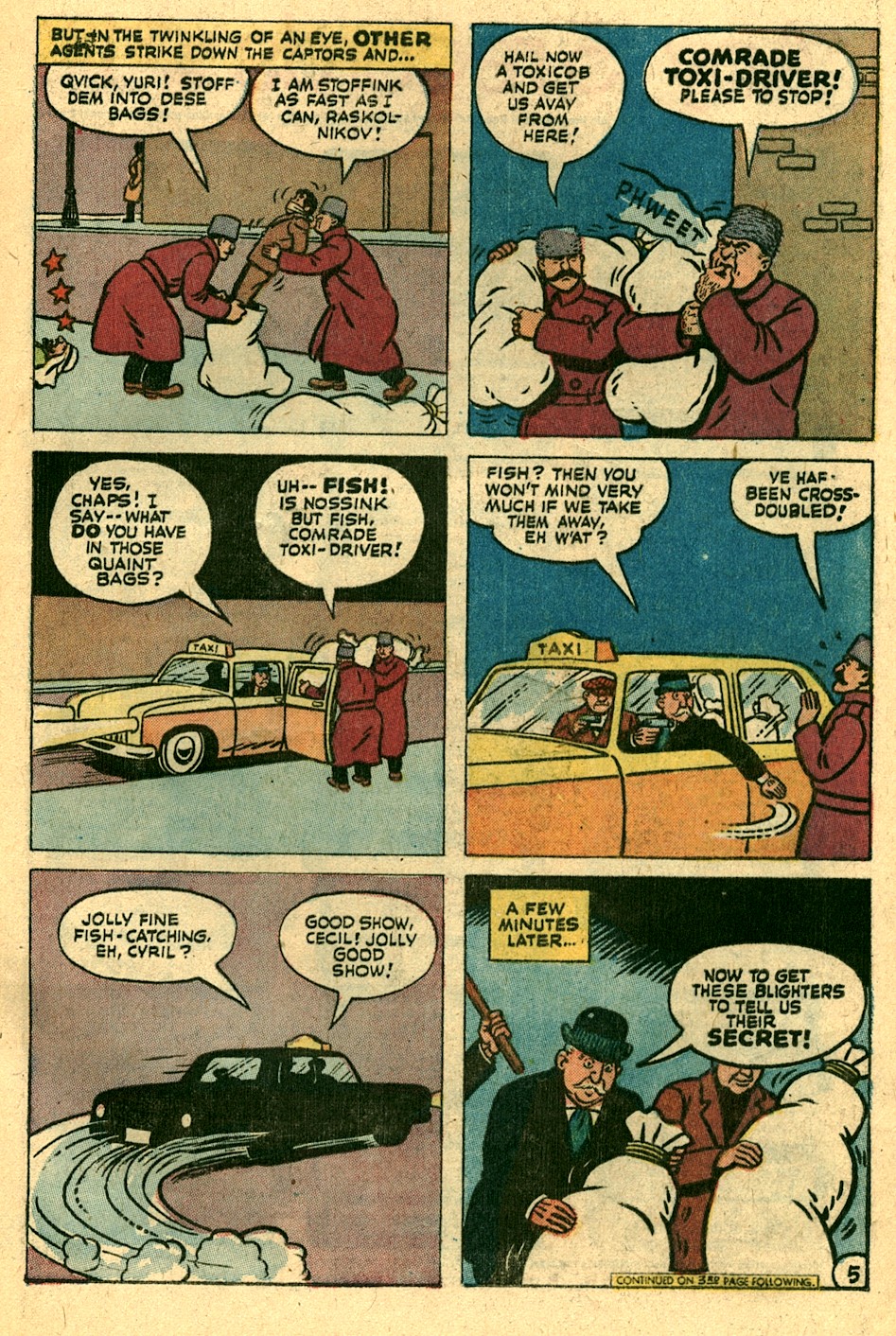 who are intercepted by French criminals, who remove Billy's gag, to make him talk and he does the switcheroo and Le Gran Fromage Rouge beats on some Frogs. Captain Marvel frees Dr Kilowatt, then a G-Man turns up (looking like Dick Tracy, with a better nose) and tells them that he must turn the invention over to the US government (Nixon was in power). He takes them to his house to show his invention, an anti-gravity device. he demonstrates it and it rips Phonograh Hill, house and all, upwards into the sky, until Captain Marvel pushes it back down. The G-Man isn't impressed, as it causes more problems than it solves and leaves in a huff. Um, it could still be used to attack an enemy and float them in the air, J Edgar Stoopid! The story comes to an abrupt end. "Witches' Tale"-Three witches are gathered in a cave (none of them is Granny Weatherwax, Nanny Ogg nor Magrat Garlick, Queen of Lancre, or even Agnes Nitt). They miss Elviry, their 4th sister and they do some conjuring to locate her, which involves a bit of harmony over the cauldron. It's 4-part, so it doesn't work so well and they go hunting the old fashioned way... 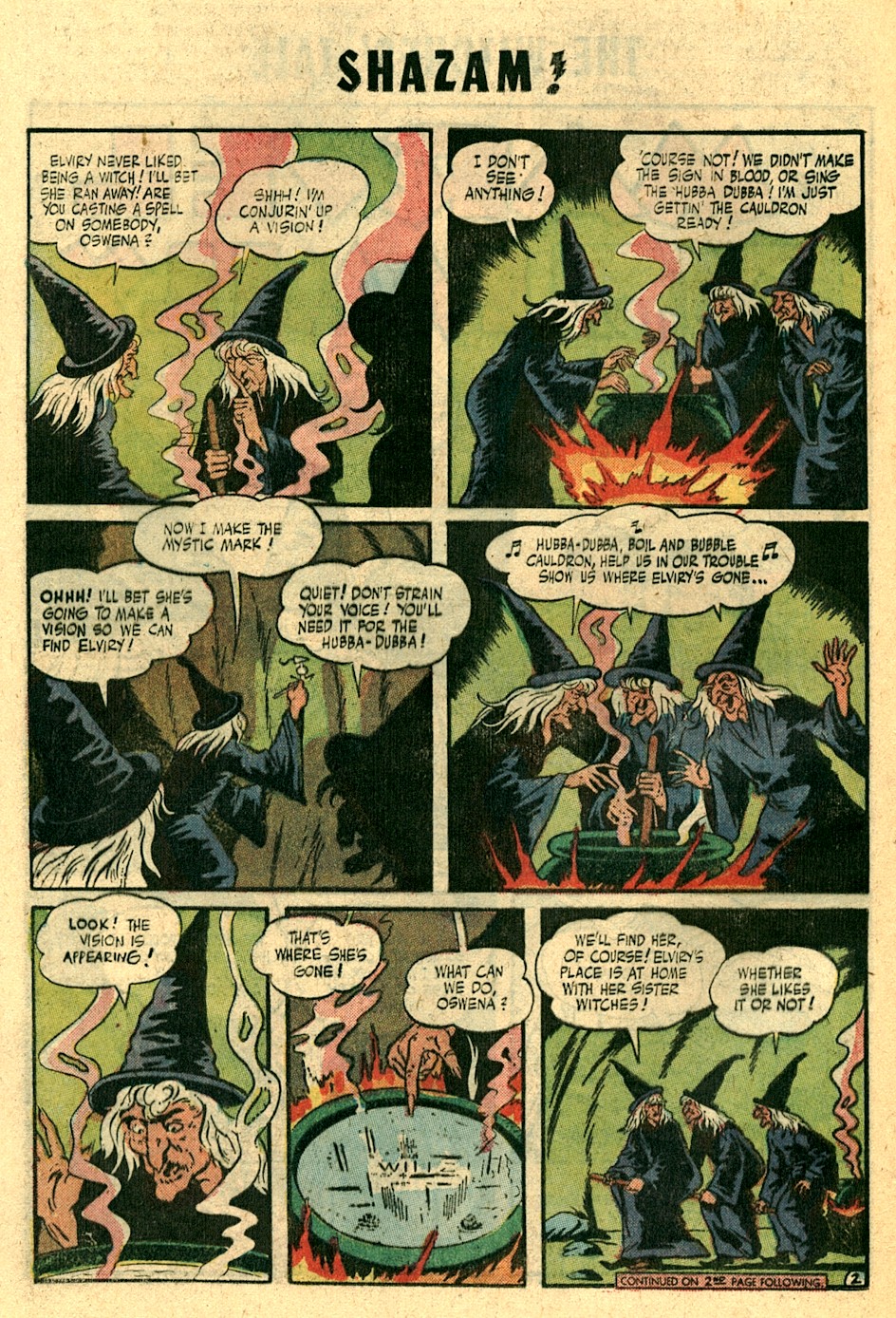 Meanwhile, Billy Batson brings in his sister, Mary, and their friend, Freddy Freeman, into the studio to see and hear the new horror show, with stories read by a woman, who makes it sound like they come from a real witch! 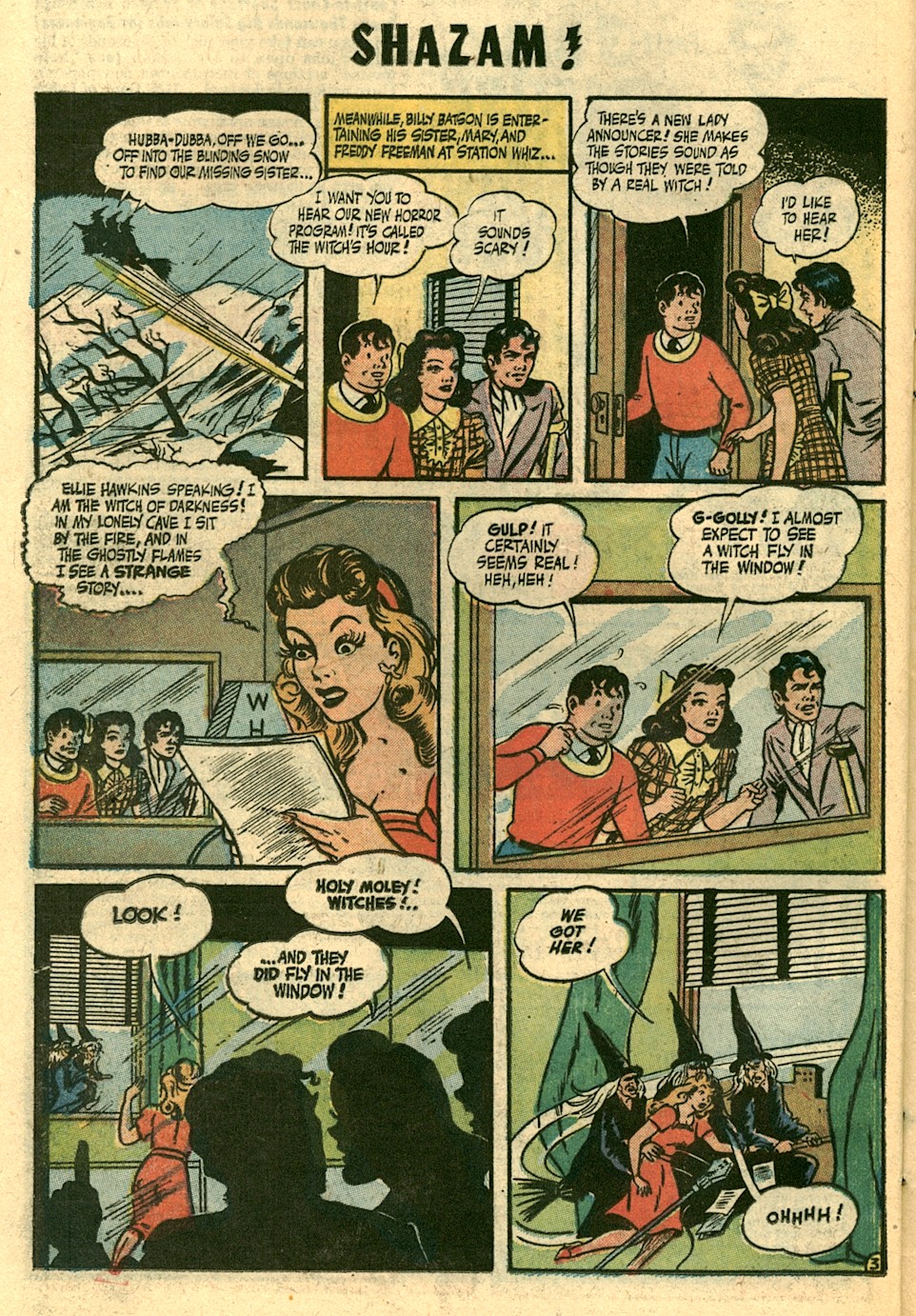 Witch? She seems pretty nice to me. Well, wouldn't you know it, Patty Maxine and Laverne turn up and witch-nap young Ellie Hawkins. The kids all do their magic trick and the Marvel Family flies after the ladies. The witches disappear into a cloud and the Marvels lose them. the Marvels split up to search a wider area. As this happens, the broom loses altitude, due to the weight of 4 people. One of their robes gets caught on a branch, on the way down, which Captain Marvel Junior finds, prompting a , "Well, thank ya, thank ya very much!" Junior tracks them to their cave, where they tell Elly/Elviry that she has to stay, like it or not, but Junior interrupts and begs to differ. mirandy casts a spell on him and turns him upside down (He can fly; why can't he just right himself?). Faster than you can say TCB!, Junior changes into Freddy and ends up rightside up. Before he can change again, one of the witches makes him taste her gumbo and he is too choked up on paprika to say the magic word. Mary turns up to punch the witches in the nose (she's a girl and allowed to hit another girl). The witch tries to scald her with the boiling water/soup. gumbo, but it has no effect and Mary knocks her into the cave wall! 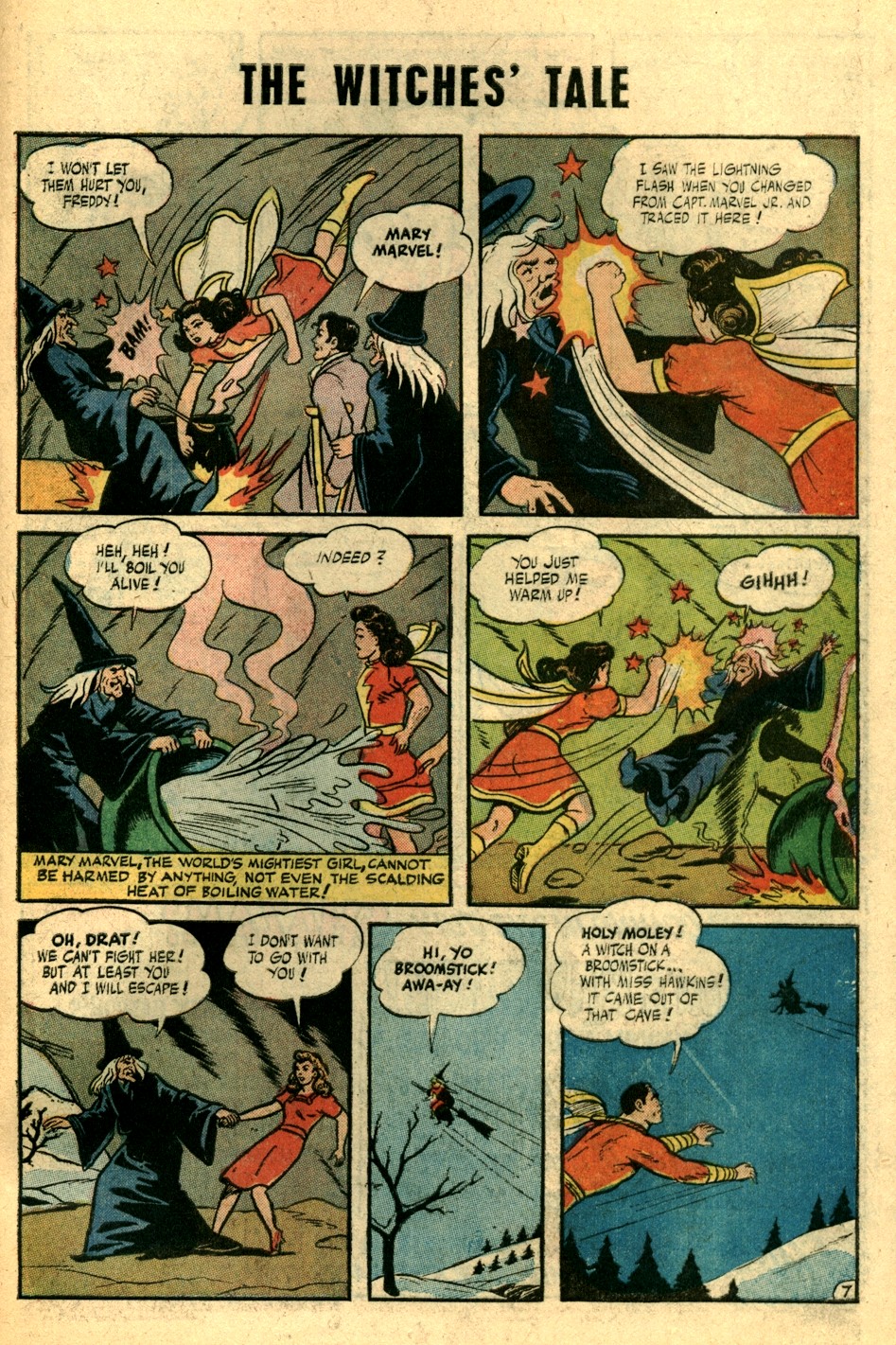 The other witch flies off with Elviry and Captain Marvel spots them and swoops down. Captain Marvel grabs the witch and frees Elviry, then lassos the other witches. Elly pleads their case and says they can be productive witches. They end up with jobs at the station, winging, "Don't sit under the poisoned appletree" and "Straighten Up and Fly This Broom Right!" 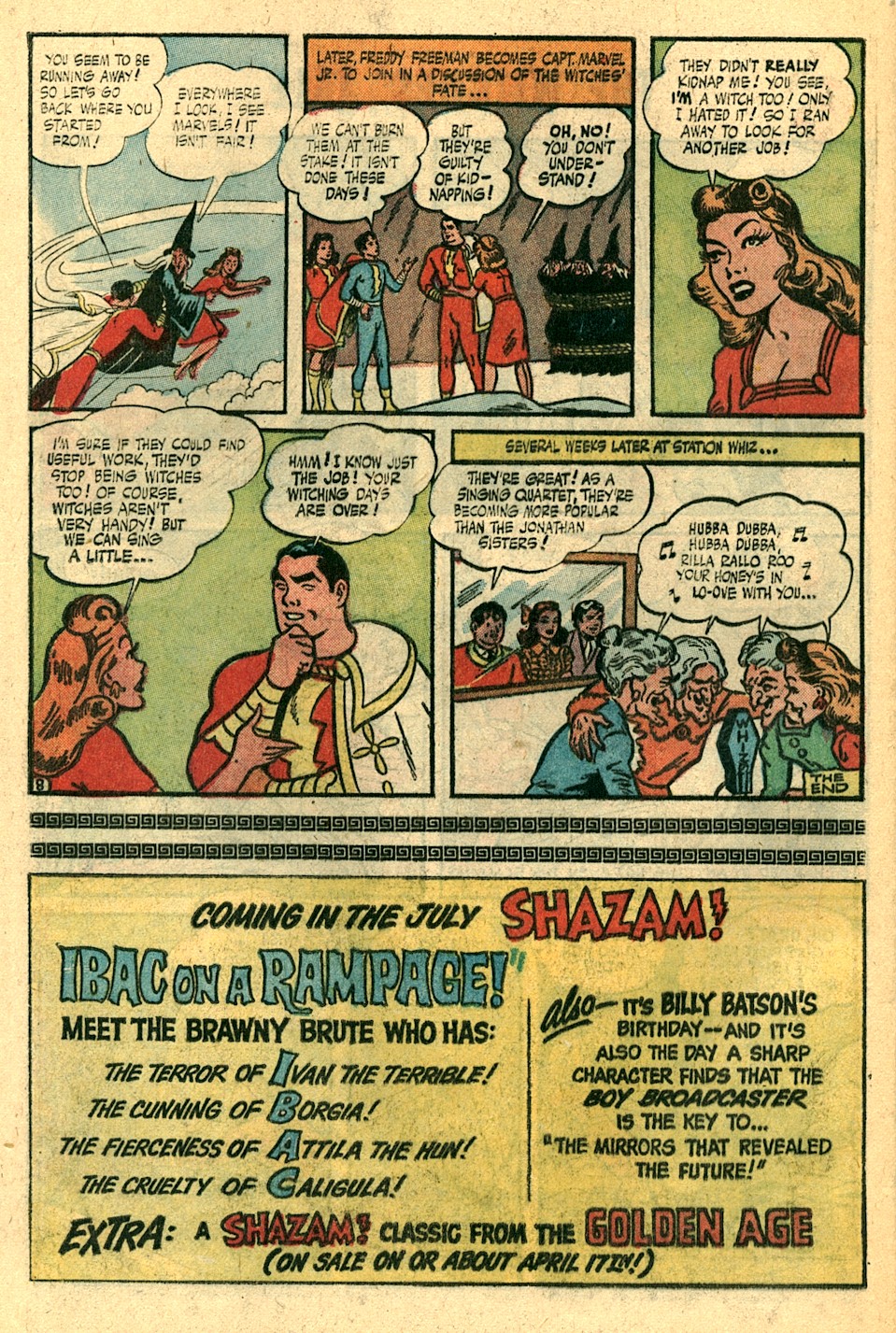 We are teased with a return of Ibac, next month. Thoughts: Well, in answer to the question as to whether Captain Marvel is supposed to be an adult Billy, the answer here is a definite no. Billy is transformed into an adult Billy, while the adult Captain Marvel gets turned into a teen Marvel. Cap also talks to the wizard on Billy's behalf, not his own; so, they are meant to be two separate people, who swap places. Sadly, Billy lacks the Wisdom of Solomon and the taste of Yves St Laurent, as that is one ugly 70s nightmare he is wearing. Thankfully, he gets a brown suit for the second story, and our eyes are spared the atrocity. Yeesh, even my mother picked out better clothes than that, and I ended up with some doozies. Nothing sucks worse than having to go to school in plaid slacks, instead of blue jeans! The main story is a vice idea, but the execution leaves a lot to be desired and Denny fails at whimsy. The ending also feels kind of abrupt. Might have worked better as a full issue story. The Maggin story is more fun, with the various enemy agents and criminals stealing from one another, reminding me of the foreign assassins in The Pink Panther Strikes Again... The only problem is, it kind of rushes the ending and it falls kind of flat, thereby blowing the set up from the better earlier material. I think the young guys are having problems pacing their scripts for the length they have. Meanwhile, Otto Binder shows them how it's done, with a delightful little tale of the witches and the latest singing sensation. You could modernize this a bit and turn them into a pop group. You can kind of understand CC Beck's frustration, as he isn't given much to really play with, in either story. We at least to get to see Junior and Mary in a classic tale, even if we still haven't gotten a modern adventure from them. In fact, we won't see one of them in a new adventure until issue #9, with junior, and then Mary, in issue #10 (written by E Nelson Bridwell, for a bit of fun with a parade balloon of Mary, ala Macy's).
|
|
|
|
Post by codystarbuck on May 22, 2021 21:02:19 GMT -5
Just because, a performance from King Marvel!  |
|
|
|
Post by codystarbuck on May 26, 2021 16:18:48 GMT -5
Shazam! #4 I could seriously use a copy of this issue to illustrate to customers, at work, that you cannot take a photo taken with a specific framing ration and magically turn it into a different ration, without either distorting the image or by adding blank space on the deficient dimension. Simple math & geometry is way too complex for the modern American, apparently. Creative Team: 1st story-Denny O'Neil-writer, CC Beck-artist, Julie Schwartz-editor; 2nd story-Elliot S! Maggin-writer, CC-Beck-artist; 3rd story-Otto Binder-writer, CC Beck-pencils, Pete Costanza-inks According to GCD, the letters page included letters from Otto Binder, Manly Wade Wellman and some snot-nosed kid, named David Micheline. Binder, obviously, was one of the ket writer of the Marvel Family, while Wellman was a pulp writer who wrote comics in the 1940s, including Blackhawk, The Spirit and the first issue of Captain Marvel Adventures. he actually testified on behalf of National, in the court battle, stating that Fawcett's editors encouraged the writers to make Captain Marvel as close to Superman as possible (much as Will Eisner testified in National's action against Victor Fox, over Wonder Man). Wellman was a popular writer for Weird Tales and one of the greats of the world of fantasy and mystery, with such characters as Judge Pursuivant, magician John Thunstone and Silver John. Synopsis: "Ibac the Cursed"-Billy is about town, getting some "man-on-the-street" opinion interviews, where he reveals his gaps in pop culture, by Asking if the St Louis Browns will take the pennant? His interview subject informs him that they became the Baltimore Orioles in the 50s. (Little St louis history from Denny, there) he moves on and sees a crowd watching a demolition crew knock down an old building. he spots a little girl on the site, close to a falling wall and utters the magic word and swoops in to rescue her... 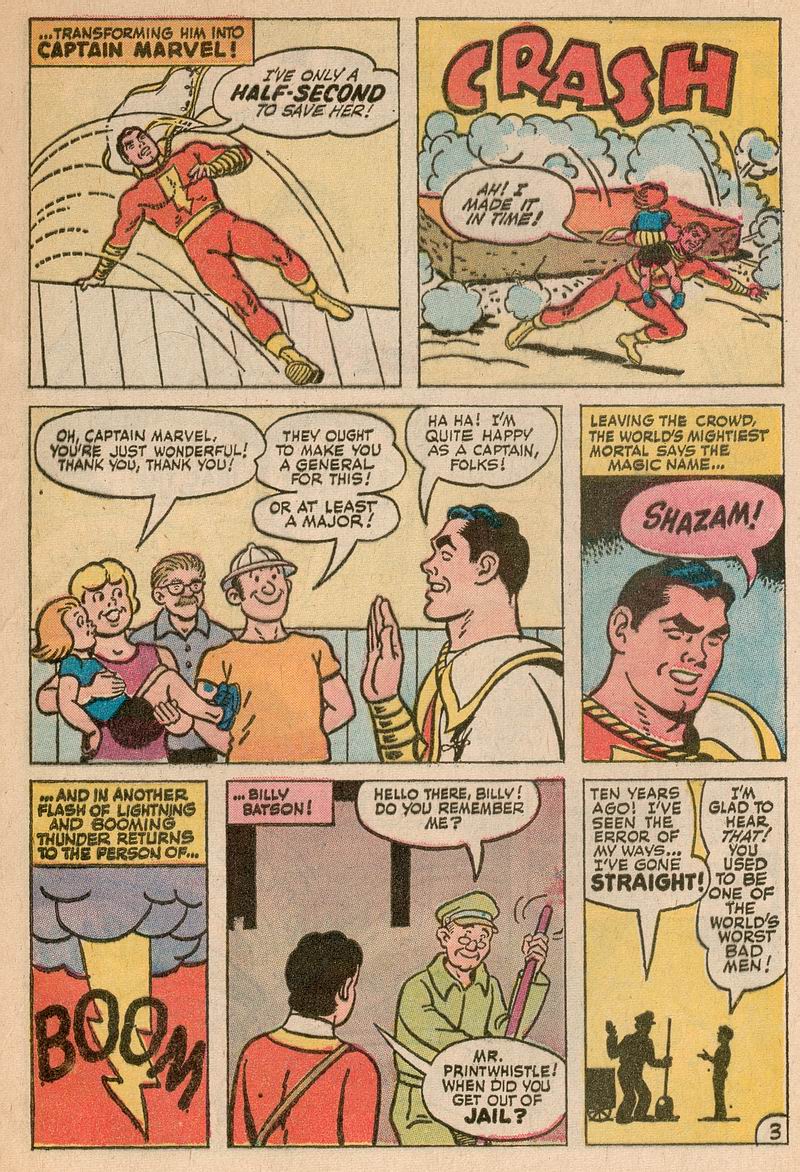 Everyone is pleased and one of the workers said he should be promoted to general. No one asks what the little kid was doing playing on the site or why there weren't safety observers, with a wrecking ball in action. Billy moves on and runs into one Stanley "Stinky" Printwhistle, a petty crook who informs Billy that he reformed and left prison 10 years ago. We are then reminded that Printwhistle was in prison because he is the alter ego of the infamous Ibac, one of Captain Marvel's more dangerous foes. His benefactors watch this situation and are not happy that the man has reformed and do their best to reverse the situation.... 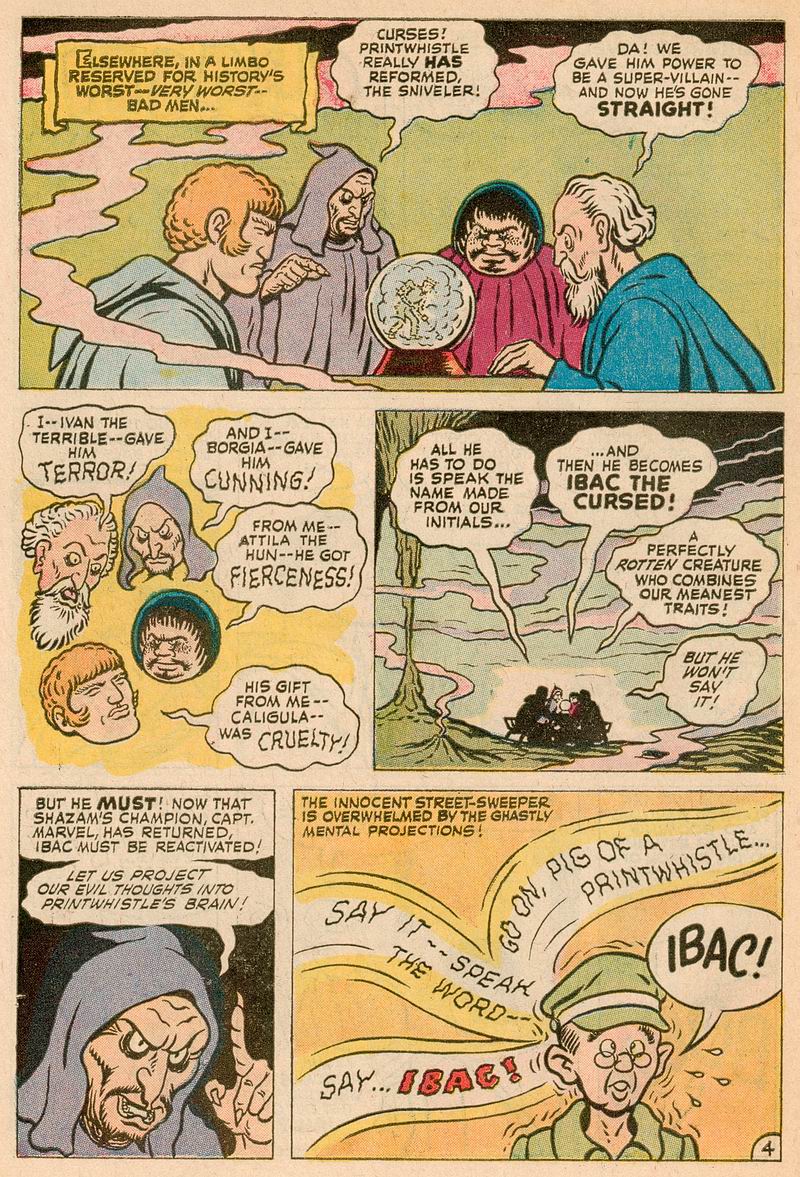 Ivan the Terrible, Cesar Borgia, Atilla the Hun and Caligula endow him with attributes, when he speaks the name, Ibac. they work to send psychic messages to him, goading him into saying the name and transforming into Ox Baker... 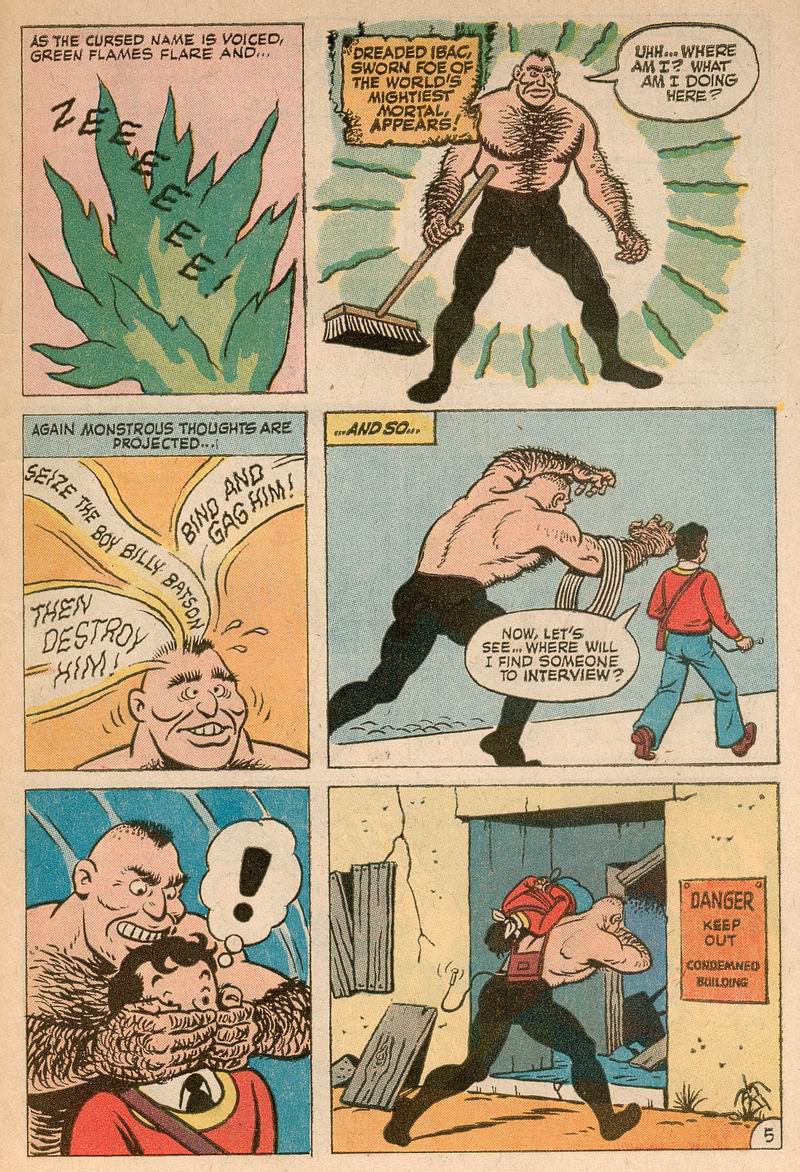  (minus the mustache and with more hair) He grabs Billy, ties him up and gags him and dumps him in a condemned building that is part of the demolition site. he leaves the helpless Billy cackling, when Billy notices his recorder was stil on. He nudges the rewind and playback buttons and the word SHAZAM! is heard, transforming Billy into Captain Marvel.... 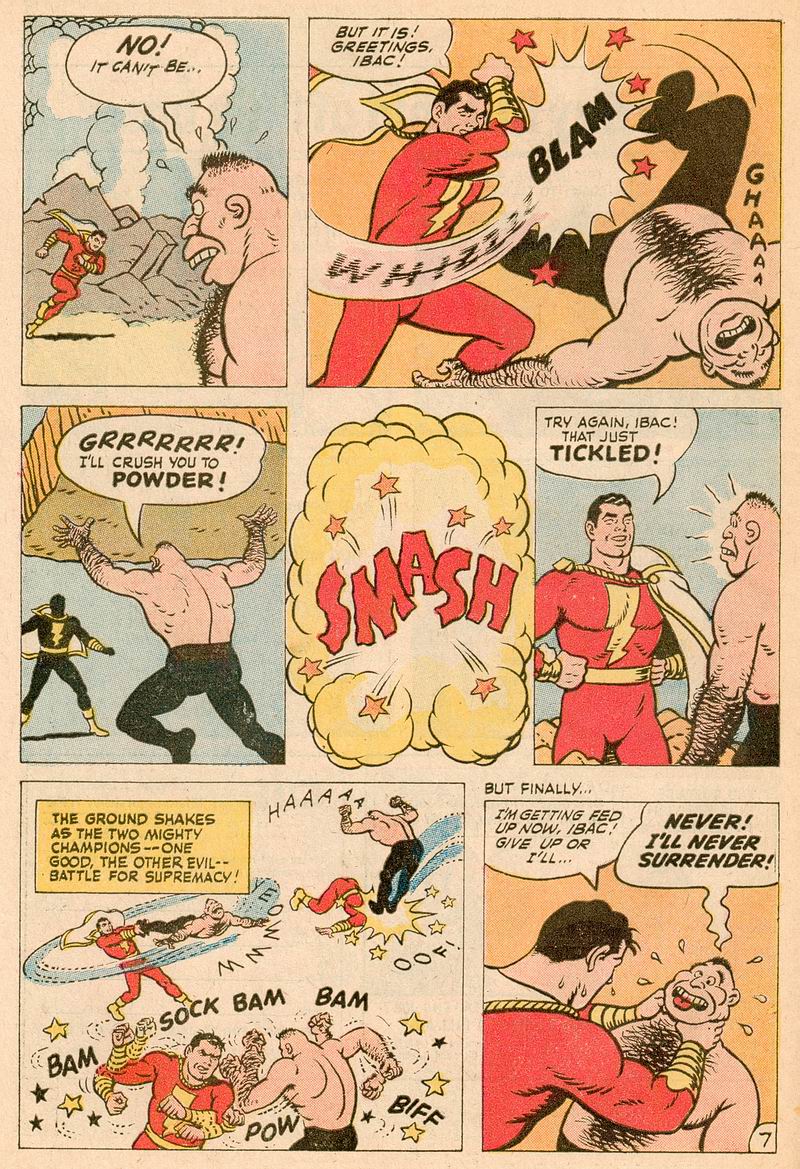 Ibac can't believe it and the pair duke it out, in a Fawcett Death Match, where falls count anywhere on the planet. Captain marvel gets Ibac in a choke and the ref allows it, since there are now rules in a Fawcett Death Match. The benefactors are disgusted at seeing their champion losing and they withdraw their attributes, causing Ibac to change back to Printwhistle, ending the bout. The ref raises Cap's hand and Prinwhistle slinks out of the ring and back to his day job. The benefactors gnarl and curse and swear to get their revenge, on the 23rd, at the Civic center. Tickets go on sale this Friday, at the box office. "The Mirror That Predicted the Future"- It's Billy's birthday and he is walking down the street, when he bumps into Robert Goulet, who cries out "Whiplash!".... 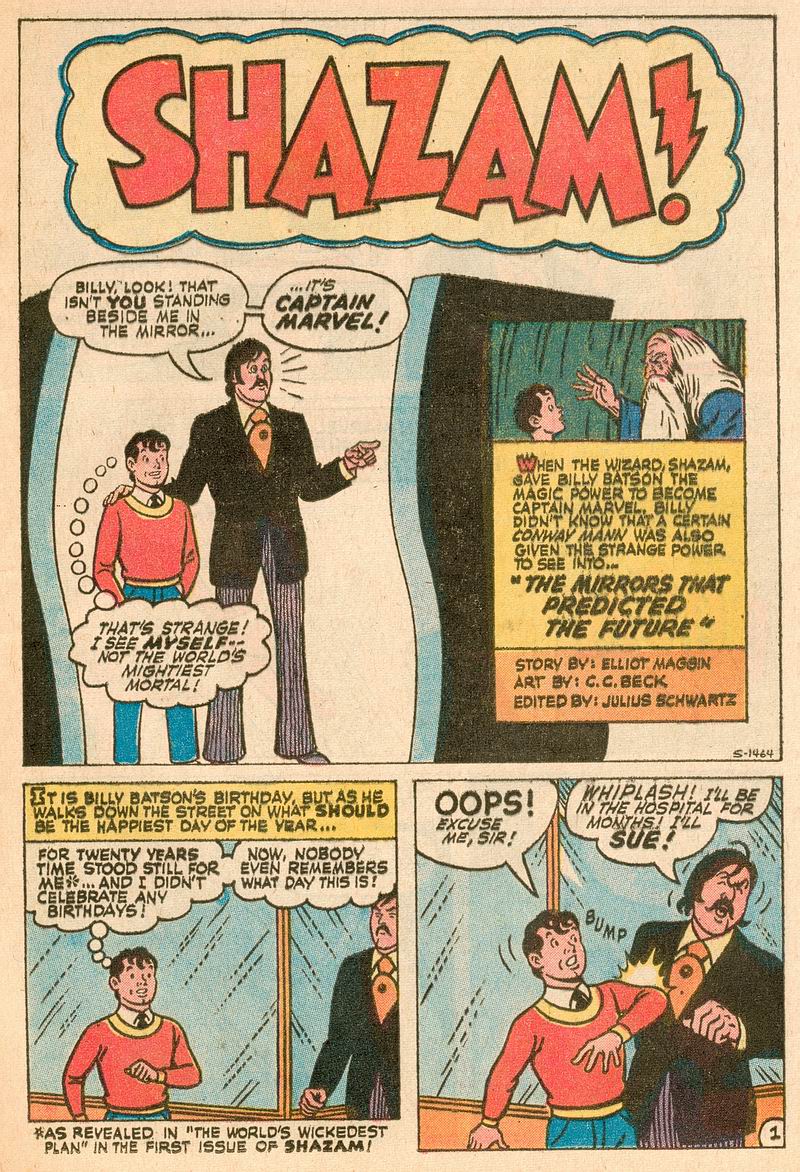 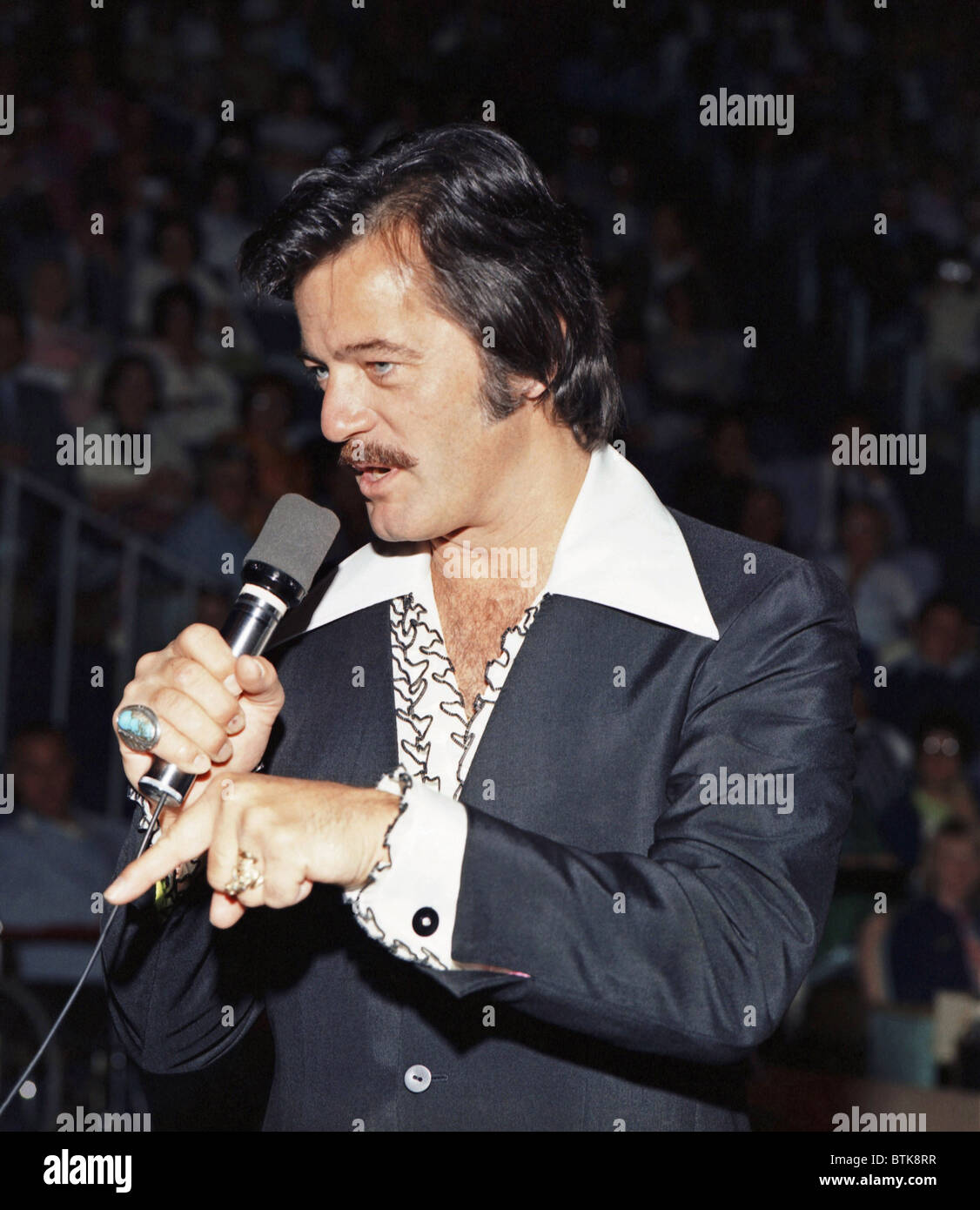 Once he hears that Billy has no money, he gets better, but then sees a mirror in a storefront window and says a plane is about to crash! Billy says the magic word and flies off into the sky, but can't find any sign of a plane in trouble. Just as he is about to give up, he spots an airplane dropping into a dive. he intercepts it and gently sets it on the ground. he switches back to Billy, while Robert Goulet looks around for him. He asks Bob how he saw the future plane crash and why he didn't ask for the words to the US National Anthem, if he was going to sing it in front of a crowd. He says he saw it in the mirror, but only when he was "touching" Billy...  Bob, or Conway Mann (Con, to his friends) sees a chance to clean up at the races and gets Billy to come along, saying they will donate the money to charity, when Billy questions the ethics of the idea. being a moron, Billy buys into that and goes off with Con Mann. While riding in Conn's sports car, Con hears a radio report about a $10 Grand reward for an escaped convict. The go on the chase and Con's vision leads them to a carnival and the house of Mirrors. The crook meets a confederate and Billy changes into Captain Marvel and the crooks flee at the sight of him. They release an elephant to occupy TBRC. He bulldogs it.... 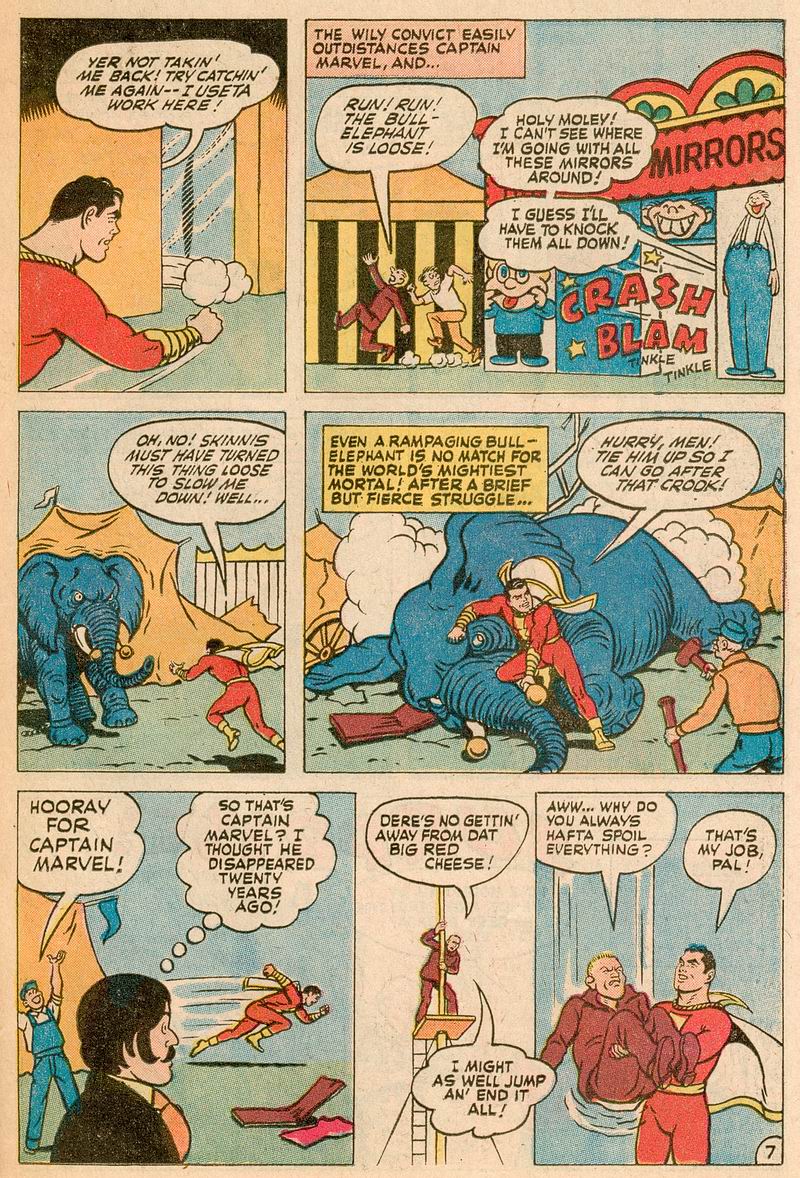 and then runs after Skinny, the crook, who is up on a high wire platform and decides to jump to his death, rather than go back to prison, but TBRC catches him. After switching back, Billy meets up with Con, who says Captain marvel turned the 10 Grand over to them; but, then, the owner of the circus carnival turns up with a bill for damages that comes out to exactly ten grand. They pay and part ways, then Billy returns home to find a surprise birthday party. So he's got that going for him. "The Ownerless Diamond"-Billy Batson is out trying to drum up interviews, but gets told to mind his own beeswax, by a scientist. Angry, Billy starts kicking objects on the ground and kicks up a big hunking diamond! He picks it up and then blurts out loud that it must be worth millions. A conveniently nearby crook decides to relieve him of it. 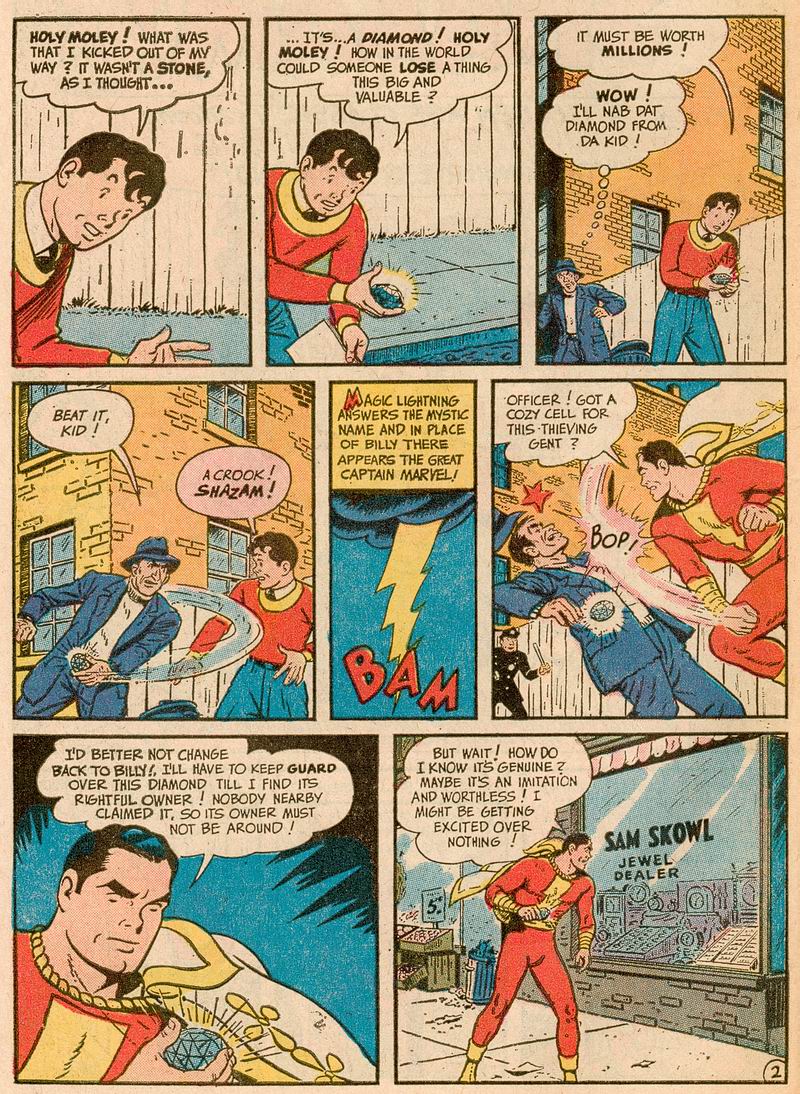 Well, he deserves to lose it, for being such a tool; but, Captain marvel retrieves it and decides to stick around to protect it and takes it to a jeweler, named Skowl. He appraises it and says it is flawless and worth millions. TBRC questions that such a diamond would be world famous, but Skowl points out all of the known biggies and says it isn't one of those. Cap leaves and goes back to the station, where he loses the Wisdom of Solomon and broadcasts the finding of the diamond and asks the real owner to come forward and claim it. Surprisingly, no one turns up for 3 days and Herr Grosser Rotter Kase thinks he will never get rid of it, when the owner, Pierpont J Van Dyke (Dick & Jerry's uncle, no doubt) turns up to claim it. Herr Kase isn't totally stupid (just mostly stupid) and asks for proof of ownership. Van Dyke starts to search and suddenly calls out about a fire... 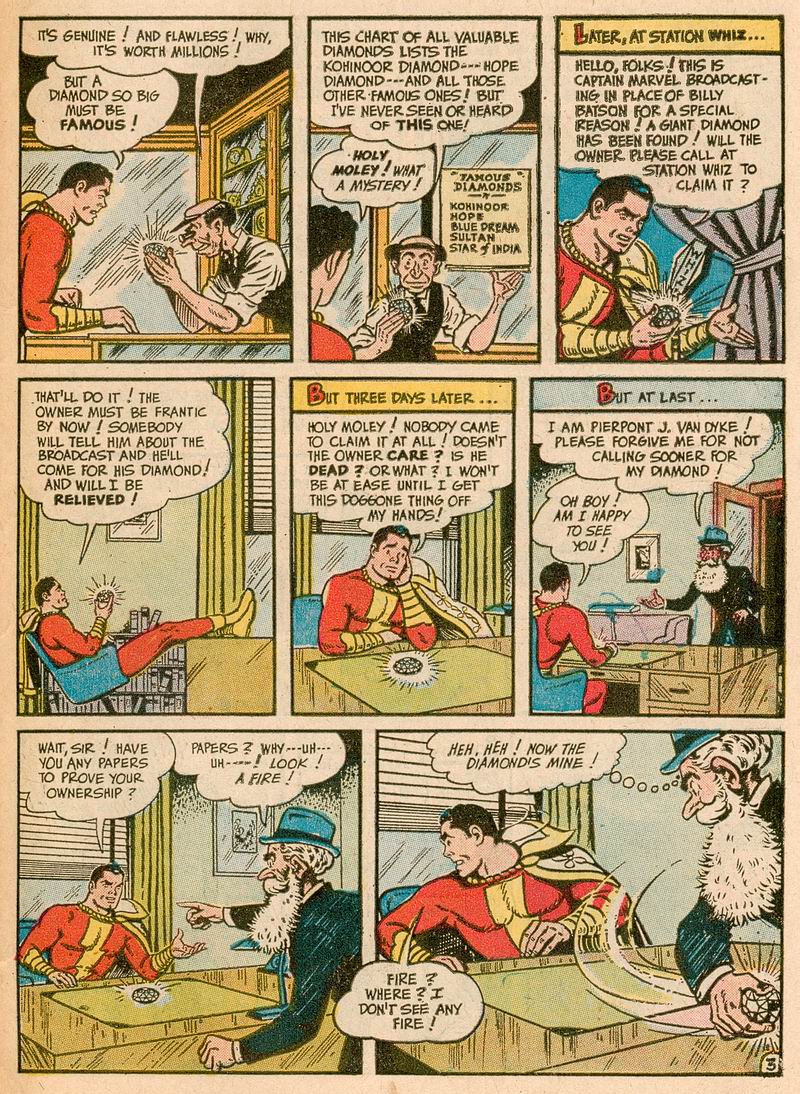 Van Dyke swipes the diamond and legs it. Captain Marvel turns back, finds the diamond gone and flies after Van Dyke, who ditches it in a coal truck (juts happening to pass by). Cap retrieves the diamond, while Van Dyke gets away and is revealed to be Sam Skowl! 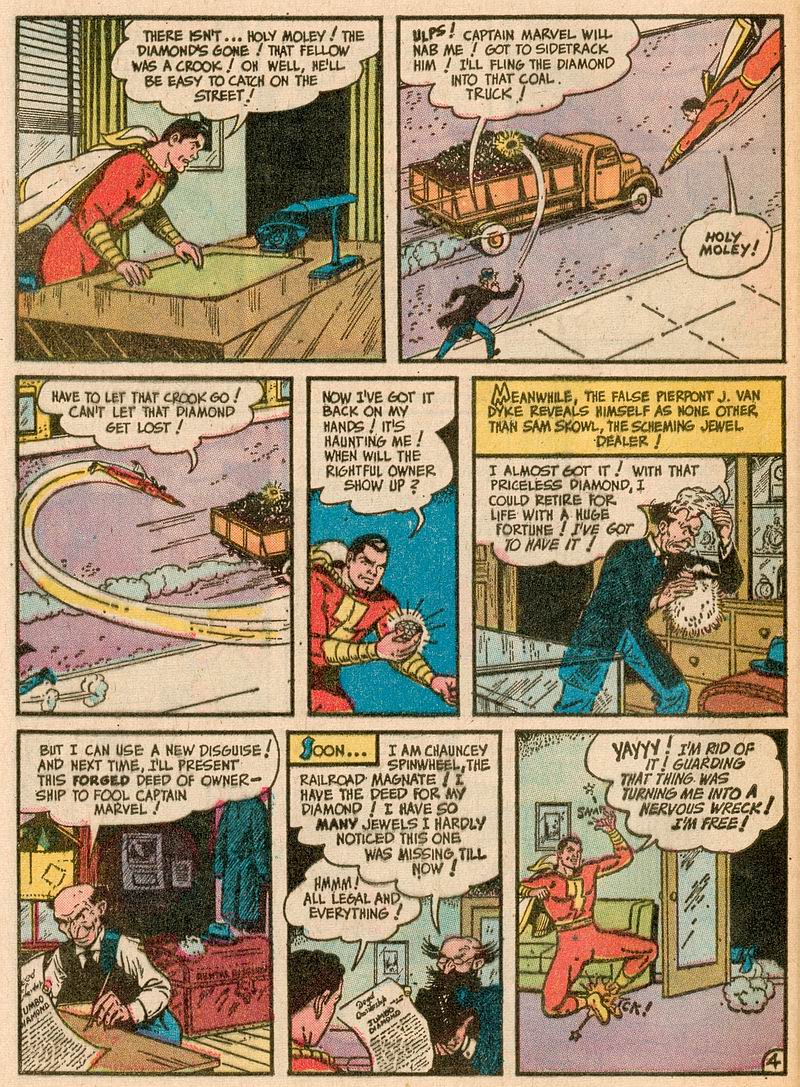 He forges ownership papers and returns as Chauncy Spinwheel, railroad magnate and claims the diamond. The Big Red Cheese Brain lets him take it and celebrates. The Skowl leaves and then gets mugged by a crook, because the fool is holding it out in the open. they fight and it rolls away and gets plucked by a beat cop. They scatter and the cop returns it to Captain Marvel, who alters the color of his trousers in response. He checks and learns that there is no Chauncy Spinwheel and goes searching the area where he found the diamond for the owner, who turns out to be the scientist who told him to scram, when he wanted an interview. Skowl turns up with a gun to steal it, shoot si tout of the professor's hands and snatches it up, only for it to crumble to dust. 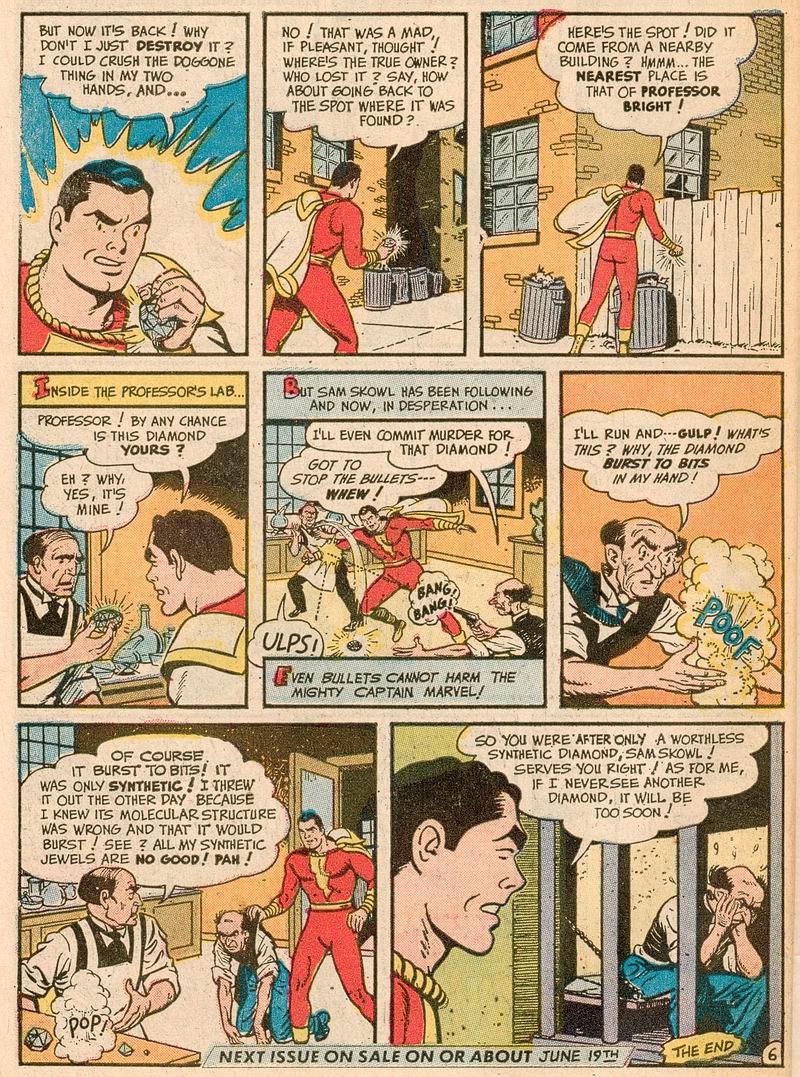 It turns out to be a synthetic diamond, with an unstable structure, which the professor tossed out, as a failure. Skowl goes to prison and mopes. Thoughts: The lead story is pretty good, if a bare bones, introducing Ibac to a new generation, then showing what a snake he is, then having him battle it out with Captain marvel, to demonstrate his power. The tape recording of Billy saying SHAZAM! is pretty convenient, but it is set up, since he is recording interviews, when the emergency comes. It would have been nice to see this play out over a longer story, to build up Ibac some more; but, since they were aiming these at young kids, they decided to use the shorter story length structure they used in other kids comic, like The Three Mouseketeers. That doesn't allow much development in an adventure strip. Still, it establishes what a stinker Ibac is, which sets him up for a return appearance. Ibac first appeared in Captain Marvel Adventures #8,. There, he is Printwhistle, who tried to blow up a bridge and was stopped by Captain Marvel. he is saved by Lucifer and given the chance to become Evil's champion, in exchange for his soul. He agrees and is imbued with Terror, by Ivan the Terrible, Cunning, from Cesare Borgia, Fierceness from Atilla the Hun and Cruelty from Caligula, which basically translates as superhuman strength, stamina and relative invulnerability. On a strength level, he is on par with Captain Marvel, but is a pretty nasty piece of work. It's never stated, but stories would imply that Black Adam and Captain Marvel are complete equals, while Ibac isn't totally and Captain Marvel's level, though he is close enough to give him a lot of trouble. Ibac would be one of the members of the Monster Society of Evil. There is a similar villain, Sabbac, who was introduced in Captain Marvel Jr #4, as an enemy of Junior. He only had two appearances, in the 40s, before E Nelson Bridwell used him in the modern stories. Ibac was used a bit more often. Ibac's appearance is based on pro wrestlers of the time frame, particularly carnival wrestlers, who took on all comers. Those performers were usually "shooters", wrestlers with a strong amateur background in technical wrestling, often able to tie opponents in knots. There were also "hookers," feared wrestlers who were trained in illegal holds and chokes which could cripple or even kill, like Lou Thesz and Ed "Strangler" Lewis (his mentor). The shooters would put on matches and take challenges from the crowd, for prize money. If a mark proved a bit too handy, they stuck him with a hooker, who would either force him to submit or deliberately injure the man to keep the money in house. Some of this continued into the established pro wrestling, into the 1970s, as noted shooters would take challenges from the crowd, to reinforce the idea of pro wrestling as legit competition. In one such instance, wrestler Bob Roop would take challeneges, while working with the Poffo Family's International Championship Wrestling (ICW) promotion. Roop was a collegiate champion and both an All-Army wrestler and a member of the 1968 US Olympic team and the real deal. He often used a worked version of the "sugar hold," an actual wrestling submission that is a combination of a half nelson and a neck crank, which causes intense pain and cuts off air flow. Roop would lock the marks into the hold, while they tried to escape, to claim a $1000 in prize money. The con backfired on Roop and the Poffos (father Angelo, aka the Masked Miser, sons Randy "Macho Man" Savage and "Leaping" Lanny Poffo, aka The Genius, in the WWF), as he locked it on a wirey young man, who was also a martial artist, who was able to wriggle out of the hold. Living up to his gimmick, Angelo Poff tried to stiff the kid on the money, until the local police got involved and the Poffos and Roop were forced to cough up the money. The challenge was quietly discontinued at matches afterward. Generally speaking, pro wrestlers wore trunks or singlets to show off their muscled bodies, while collegiate wrestlers wore long tights, with knee pads sewn in, for traction on the mat. Pro wrestlers usually only wore long tights when they were going to have a "shoot" match, where the fight was real, which was usually confined to a private location, witnessed only by "the boys." Ibac's cosume is pretty much what wrestling long tights looked like then, apart from the built in knee pad. 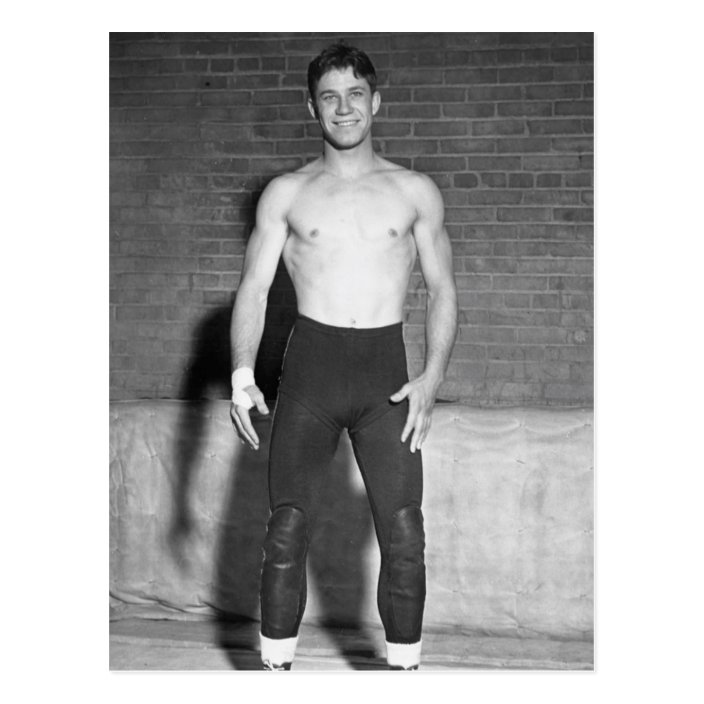 Ibac's general size and body shape tends to match the burlier pro wrestlers of the era, long before bodybuilding and steroids took hold, in the 1970s. The second story, from Elliot Maggin, has a better grasp of the lighter elements of Captain Marvel, but, again, story length doesn't allow much development of the plot before it is over. I have no idea if it was intentional, but CC Beck makes Conway Mann look just like Robert Goulet, in the 1970s (with a droopier mustache). Beck doesn't visualize the future predictions, which seems a bit odd. The opening page establishes that Con sees things in the mirror that Billy doesn't, though you'd think they'd want to visualize the prediction. My guess is that Julie Schwartz or someone else though it might be too confusing to kids for Con to see it and Billy not, if it is right there on the page. One thing to not in these stories is the simplicity of the backgrounds. Beck gives you what is essential for the story, without much int he way of extra details and yet it is stillmore background than you would get in other adventure comics, aimed at older audiences. Even in the 70s, there was criticism of simplistic panels, with only color backrgrounds, with the trend getting worse in the 8os and 90s. A lot had to do with comic artists coming from fan ranks, learning by copying existing omics, rather than being trained in more extensive art instruction or apprenticeships. Apprentices usually started out drawing backgrounds or minor characters, before they got to handle principle figures and story. Sometimes it was a matter of speed, to make the deadline or a reflection of low page rates. If you compare to the reprint, the details are much more pronounced, though some of that is Pete Costanza's inks, as Beck tended a bit more to simplicity, though his Fawcett stories had more defined details than some of his DC stuff. Then again, Beck is doing full art and lettering, here. The reprint story, once again, is the superior one, as Binder puts together a nice, if implausible plot, then adds little complications on the way, which build on the joke, reaching a nice conclusion, with a bit of an O Henry ending. Skowl keeps getting foiled in stealing the diamond and captain Marvel keeps getting foiled in getting rid of it, honestly. In the end, it turns out to be a fake, created by the scientist and the beginning of the story, who seemed like a throwaway character. Tying him back in at the end gives a nice circular conclusion, which isn't telegraphed at the start. This is the kind of fun little morality tale you could get in the Marvel Family adventures, as well as other Golden Age comics; and, indeed, other children's literature. It doesn't so much talk down to kids as give them some humor, adventure and fun, in a clean, clear manner that lets them enjoy the story and learn a lesson. That art got lost as comics became more and more about the adventure and the target audience grew older and older. As the 70s progressed, comics aimed at young kids, just beginning to read, fell by the wayside, while the main comics titles started aiming more at pre-teens, eventually pushing on to teens and adults. Young kids were pushed completely aside when those sources disappeared, from DC & Marvel and companies like Harvey went out of business. Archie weathered things better, but their market share was greatly diminished as kids found other outlets to provide them with humor and adventure as comics once did. Those kids would grow up without ever reading comics (or reading many of them). As new readers entering the market declined, comics focused more and more on existing audiences, especially with the rise of the Direct Market. Now, it is pretty much a specialty niche audience, closed to those who would have read comics even just a decade before. Captain Marvel's child protagonist made it a perfect vehicle for the wish fulfillment of kids; but, the more he was turned into a straight adventure hero, the more that audience was abandoned, until DC tried it again, with Billy Batson and The Power of Shazam.
|
|
|
|
Post by codystarbuck on May 29, 2021 19:23:28 GMT -5
Shazam! #5 Captain Marvel being attacked by the letterer, on this cover! Creative Team: 1st & 2nd story-Elliot S! Maggin-writer, CC Beck-artist, Julie Schwartz-editor; 3rd story-Joe Millard-writer, Sheldon Moldoff-artist. Synopsis: "The Man Who Wasn't"-A hobo, named Slip Kelly, spots a figure sleeping, while hovering in the air, above the trash cans, in an alley. Faith and begorah, wouldn't ya know it? 'T'is a leprechaun and Kelly, being an old son of Ireland, catches the leprechaun and makes him grant him a wish, I don't mind sayin'. Slip is in the way after being invisible and sure if the leprechaun doesn't grant the wish, bein' the law and t'ings. 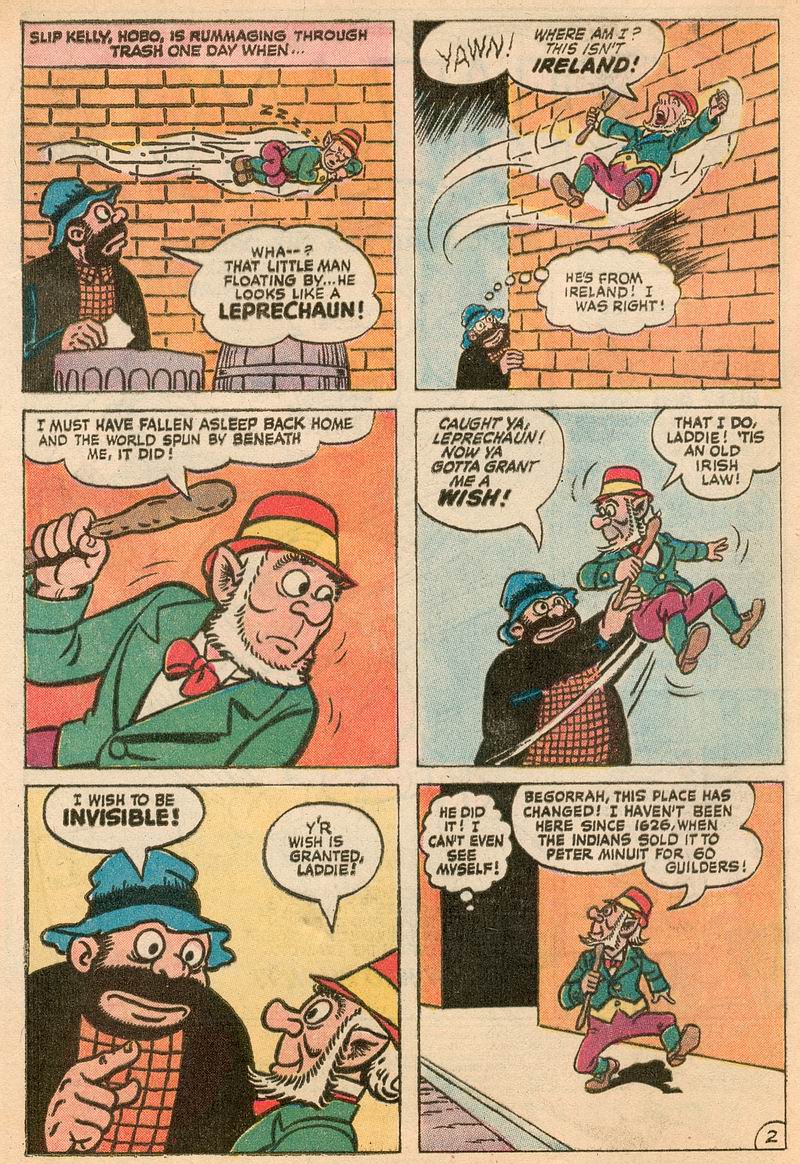 The leprechaun wanders off and would you be knowing where Slip Kelly took himself? Well, sure and Father Ted just let that money rest in his account, old Slip goes into a bank and relieves them of a bit of their financial burden, in the way of a large withdrawal, without creating unnecessary bureaucracy, like proving the money was from his account, with a withdrawal slip. Would you believe it that Billy Batson just happens to be in the bank and witnesses the money floating away. He says the magic word, and Captain Marvel yells "Stop, thief!" but comes to a conclusion that it can't be stealing if you can't see a thief. You can't argue with that kind of logic....not, without getting a headache and need a bit of the porter to cool it off. Two men spot the money float and say to themselves, "Pat & Mike, that money is floating with no owner, which means there is a share for us, seein how there is no owner moving it." Well, now, they chase after the money and it floats over some wet cement and footprints appear, with Captain Marvel turning up at the other end. The money says it is trapped and flies out in all directions, while some unseen man says he's getting out of there. 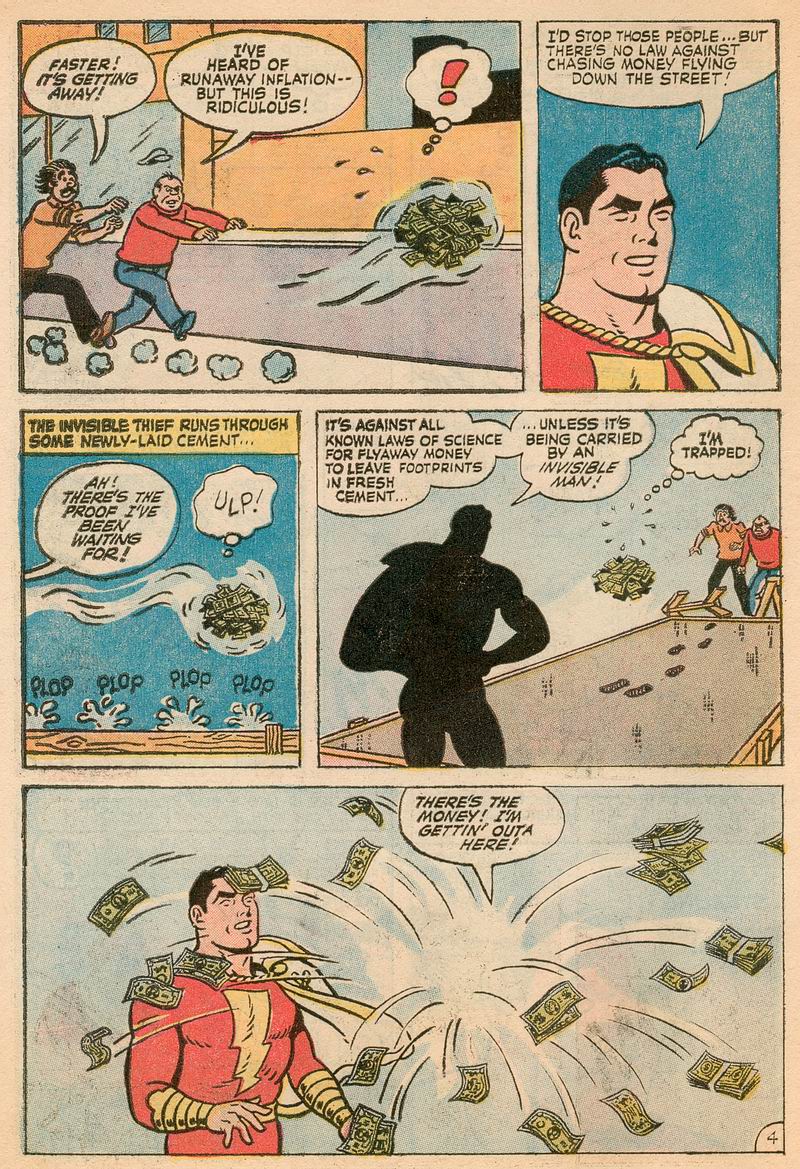 Well, I'd continue, but me throat is rather parched........ .....Now that does the trick! No where was I? Captain Marvel chases down the money, then spots the leprechaun and has a word with him and the wee man finds him a bit of an oaf and taunts him, until Captain Marvel switches with Billy and Billy surprises the leprechaun and grabs him. He tries to trick a wish that will return the thief, but it doesn't work that way; the original wisher has to catch the leprechaun and make him change things. (I don't recall this one when I last set foot on the Emerald Isle). Billy switches to Captain Marvel and he opines to have the leprechaun grant his wish that the thief catch the leprechaun again. Captain Marvel catches Slip Kelly, while trying to steal hot dogs and drags him around, placing him in danger from thing that can't see him, until he wishes away his original wish. Captain Marvel then puts him in a nice cell and the leprechaun goes off to get Maureen O'Hara's autograph! "The World's toughest Guy,"-Billy Batson is out collecting newspapers for recycling (door to door) and gets the door slammed in his face. he decides to get Sunny Sparkle to help, since no one can turn him down. he brings along his cousin Rowdy, who Billy doesn't warm to. they go back to the house where Billy got a door in the face and, this time, Archie Bunker gives him newspapers and Edith invites Sunny in for cookies and milk.... 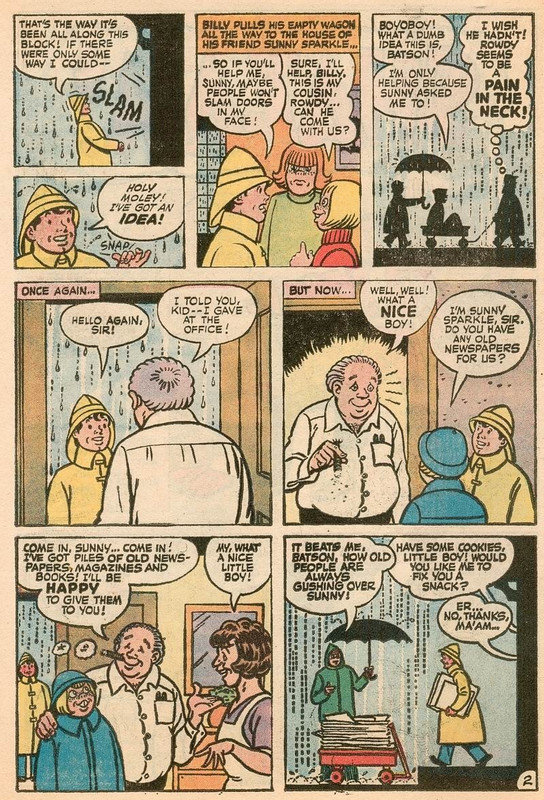 They leave and Archie tells the dingbat to shut the door, before another meathead gets in! The boys stop to rest (because Rowdy is nagging) and look at a book the Bunkers gave them. It is titled "How to Do Everything," and has blank pages and an index, with writing. They look at the index and their is a listing for how to stop rain and they turn to that page and writing appears, and then the rain stops. Right after, they forget how they did it. they turn the newspapers over to Sterling Morris and Rowdy takes the book. He sees How to Be The Toughest Man in the World, and turns to the page. Mr Morris nearly runs into him but Rowdy grabs the forklift and rights it, then insults Mr Morris. Captain Marvel (Billy changed when Mr Morris lost control) chastises him and Rowdy tells him to go boil his head. Captain Marvel decides to egg him one and goads him into tearing a phone book, which he does, then captain Marvel tears the magic book up. He then goads Rowdy into punching him, nearly breaking his hand. He then tries kicking and headbutting Captain Marvel and TBRC asks Sunny to take his cousin away before he gets killed. "Captain Marvel Jr Fights the Champ"-The Champ is coming down the street and the neighborhood boys spot him and bother him for an autograph. he tells the bums to go away and they don't listen, so he clips one around the ear and knocks him into the street, where a car is rushing toward him. Freddy Freeman sees this and calls on his favorite hero and turns into Captain Marvel Junior. 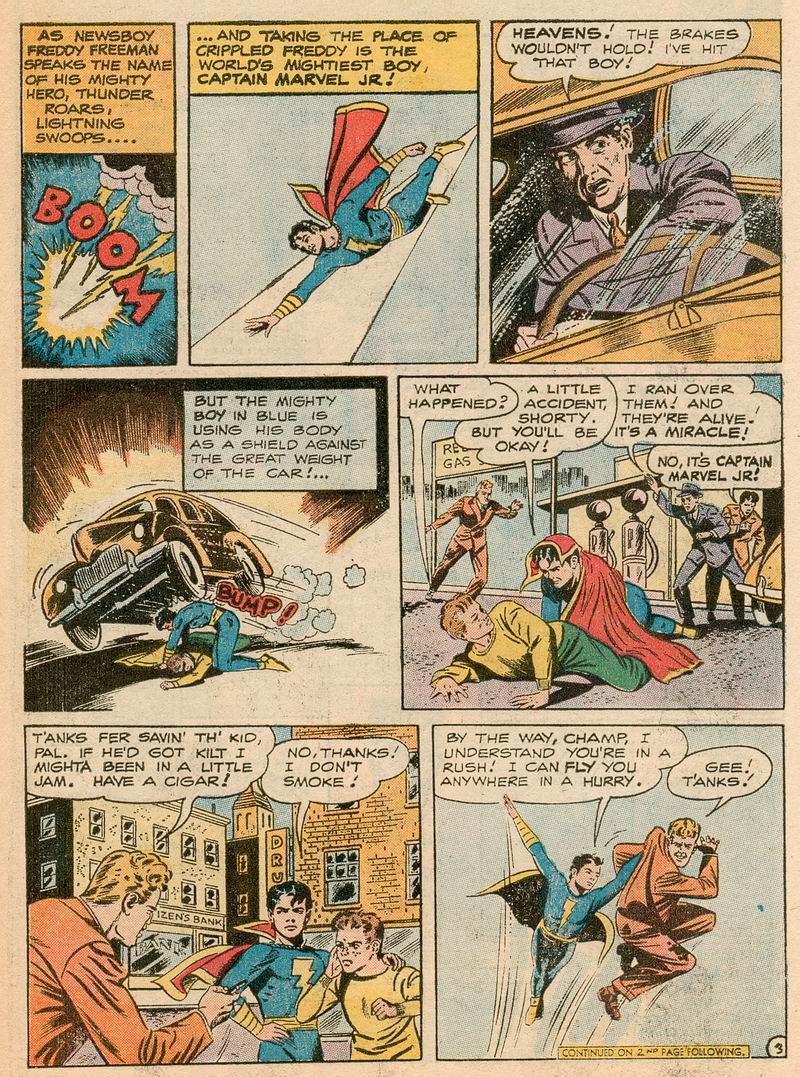 Junior swoops down and covers the boy, protecting him from the car, which rolls off Junior's body. The kid is find and the Champ apologizes. Junior offers him a lift and flies him to where he wants to go. he stops a bit early, asks the Champ why he slugged the kid and he answered because the kid got his suit dirty. So, Junior dumps him in a barrel of waste oil and makes it dirtier. The Champ tries to slug him and nearly crushes his hand. Junior dumps him in a lake and drags him out and back to Freddy's room at the boardinghouse, to recover. He shows the Champ Freddy's pictures of him and says Freddy and other kids look up to him. The Champ asks why he took him off to a private spot to humiliate him, instead of in front of the kids and Junior says he didn't want to disillusion the kids. the Champ says he was going to meet some crooks who were going to pay him to throw a fight, which Mrs Wagner (who owns the boardinghouse) overhears and chastises him, having been a friend of the Champ's late parents. The Champ goes back and tells off the hoods and it gets physical, then one pulls out a rod and Junior turns up to protect the Champ. 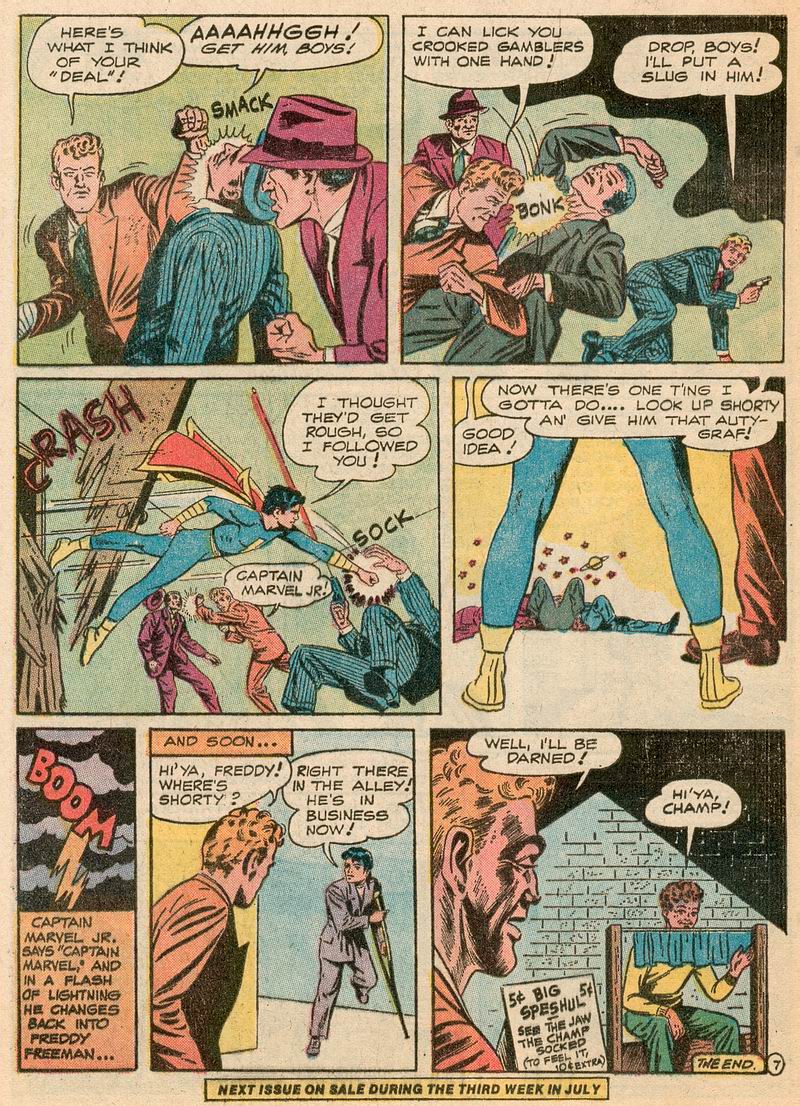 Thoughts: Thoughts: The first two stories are pretty lame, even for young kids. The second one has a germ of an idea, but never really develops it well, so Captain Marvel doesn't mess with Rowdy very long. It seems an abrupt end to an abbreviated story. Archie & Edith make a cameo, as they did in other comics in this era, as All In The Family was a really big deal. The Fawcett reprint shows Captain Marvel Junior and shows the more illustrative style to his adventures, though in the form of Sheldon Moldoff (who also drew Hawkman and Batman), rather than Mac Raboy, who drew Junior's adventures in his own comic (this was from Marvel Family Adventures #25). It's fine, with a nice morality tale, though a bit light for Junior. Captain Marvel Junior made his debut in Whiz Comics #25. The issue was part of a 3 comic epic, with Captain Marvel and Bulletman fighting Captain Nazi. Captain Nazi smashes the boat where Freddy Freeman and his grandfather were doing some fishing, killing grandpa. Freddy is badly hurt and Captain Marvel takes him tot he Wizard for help. He tells the boy to speak the name of his hero and he says "Captain Marvel!" and is transformer into Captain Marvel Junior. Junior's adventures were drawn most significantly by Raboy and his own book was hugely popular, a favorite of young Elvis Aron Presley, who later got his hair cut to look like Junior, then took inspiration for his jumpsuits from the Marvel uniforms, as well as his TCB logo. Other than the debut story, this is Junior's first story appearance, though in a reprint. Still no new stories for the youngster. Junior actually predates Superboy and there is some conjecture that his success spurred on Superboy's creation, at National. Junior had my favorite costume of the Marvels, with the blue uniform, with yellow accenting and the red an yellow cape standing out, with the other Marvels. It reproduced quite well, too. Of course, the color scheme is far closer to Superman than Captain Marvel. As we see here, DC's writers are having a tough time writing interesting short stories and this is probably the least interesting issue, so far. Other than the Fawcett reprint. you could skip the whole thing.
|
|
|
|
Post by zaku on May 30, 2021 7:05:59 GMT -5
As we see here, DC's writers are having a tough time writing interesting short stories and this is probably the least interesting issue, so far. Other than the Fawcett reprint. you could skip the whole thing. Putting aside their ability to write compelling adventures, did DC think that in the 70s there might be an audience that wanted to read these kinds of stories? |
|
|
|
Post by chaykinstevens on May 30, 2021 7:31:31 GMT -5
Creative Team: 1st & 2nd story-Elliot S! Maggin-writer, CC Beck-artist, Julie Schwartz-editor; 3rd story-Joe Millard-writer, Sheldon Moldoff-artist. I remember reading some Western novels in the 70s by a Joe Millard, about Clint Eastwood's Man with No Name. Do you know whether this would have been the same guy? |
|
|
|
Post by MDG on May 30, 2021 9:56:26 GMT -5
As we see here, DC's writers are having a tough time writing interesting short stories and this is probably the least interesting issue, so far. Other than the Fawcett reprint. you could skip the whole thing. Putting aside their ability to write compelling adventures, did DC think that in the 70s there might be an audience that wanted to read these kinds of stories? Maybe, but in a way, this kind of thing was off a brand for DC. Maybe they were thrown off by the way fandom at the time still had a strong Golden Age focus. You could go to a NYC convention and get the impression folks were clamoring for GA creators, but they weren't DC's main customers. |
|
|
|
Post by codystarbuck on May 30, 2021 10:21:21 GMT -5
Creative Team: 1st & 2nd story-Elliot S! Maggin-writer, CC Beck-artist, Julie Schwartz-editor; 3rd story-Joe Millard-writer, Sheldon Moldoff-artist. I remember reading some Western novels in the 70s by a Joe Millard, about Clint Eastwood's Man with No Name. Do you know whether this would have been the same guy? I don't have concrete proof; but I suspect it is. That author was Joseph J Millard, who wrote a lot of genre fiction and similar fare and was selling stories to Thrilling Wonder Stories, in the 1940s. That would fit well with comic book writing, as some writers dabbled in comics between magazine sales (like Otto Binder). He wrote some material for the Fawcett paperback line, which would make it seem highly likely it's the same guy. |
|
|
|
Post by codystarbuck on May 30, 2021 10:29:23 GMT -5
As we see here, DC's writers are having a tough time writing interesting short stories and this is probably the least interesting issue, so far. Other than the Fawcett reprint. you could skip the whole thing. Putting aside their ability to write compelling adventures, did DC think that in the 70s there might be an audience that wanted to read these kinds of stories? In the 1970s, Harvey Comics had a huge audience, with Richie Rich and even Casper. DC was still publishing romance comics, aimed at girls. They had had stuff like The Three Mouseketeers and Fox and the Crow not long before. There was an audience; but, they didn't have the best guys working on this kind of material. O'Neil and Maggin were excellent superhero writers; but, their more realistic approaches flew against what made Captain Marvel charming. Captain Marvel was one of the biggest of Golden Age heroes and there was a huge fandom for that; but, they weren't the audience for that DC aimed at. The first issue was snapped up by speculators, but that was about it, as the series settled into at least DC's mid-range. Like I said before, had Filmation not come along with the live-action series, I doubt the comic would have run as long as it did. DC improved things when E Nelson Bridwell and Kurt Schaffenberger took over and even more when Don Newton came on as artist. Had they started out with Bridwell and Newton, I suspect it might have been a different story. Fans wanted the villains and the whole Marvel cast and Bridwell gave them that, while these early ones reintroduce some of the villains; but don't do much with them, other than the Mr Mind story. Ibac wasn't bad, but could have used more room to play. |
|
|
|
Post by Rob Allen on Jun 2, 2021 14:25:37 GMT -5
Catching up a bit... From issue #4: The name was a nod to a Red Skelton character, Bolivar Shagnasty - red-skelton.info/tag/bolivar-shagnasty/I recognized it, then and now, because my father used that name as a negative example - "Don't be a Bolivar Shagnasty!" It wasn't until the Google era that I found out where it came from. |
|






























